- History Classics
- Your Profile
- Find History on Facebook (Opens in a new window)
- Find History on Twitter (Opens in a new window)
- Find History on YouTube (Opens in a new window)
- Find History on Instagram (Opens in a new window)
- Find History on TikTok (Opens in a new window)
- This Day In History
- History Podcasts
- History Vault

Battles of Lexington and Concord
By: History.com Editors
Updated: March 28, 2023 | Original: December 2, 2009

The Battles of Lexington and Concord, fought on April 19, 1775, kicked off the American Revolutionary War (1775-83). Tensions had been building for many years between residents of the 13 American colonies and the British authorities, particularly in Massachusetts. On the night of April 18, 1775, hundreds of British troops marched from Boston to nearby Concord in order to seize an arms cache. Paul Revere and other riders sounded the alarm, and colonial militiamen began mobilizing to intercept the Redcoat column. A confrontation on the Lexington town green started off the fighting, and soon the British were hastily retreating under intense fire. Many more battles followed, and in 1783 the colonists formally won their independence.
Lead-Up to the Battles of Lexington and Concord
Starting in 1764, Great Britain enacted a series of measures aimed at raising revenue from its 13 American colonies. Many of those measures, including the Sugar Act, Stamp Act and Townshend Acts , generated fierce resentment among the colonists, who protested against “taxation without representation.” Boston, the site of the 1770 Boston Massacre and the 1773 Boston Tea Party , was one of the main points of resistance. King George III of Britain ramped up the military presence there, and in June 1774 he shut down the city’s harbor until colonists paid for tea dumped overboard the previous year. Soon after, the British Parliament declared that Massachusetts was in open rebellion.
Did you know? Paul Revere never shouted the legendary phrase later attributed to him (“The British are coming!”) as he passed from town to town during his midnight ride on April 18, 1775. The operation was meant to be conducted as discreetly as possible since scores of British troops were hiding out in the Massachusetts countryside. Furthermore, colonial Americans at that time still considered themselves British.
On April 18, 1775, Joseph Warren, a physician and member of the Sons of Liberty, learned from a source inside the British high command that Redcoat troops would march that night on Concord. Warren dispatched two couriers, silversmith Paul Revere and tanner William Dawes, to alert residents of the news.
They went by separate routes in case one of them was captured. Revere crossed the Charles River by boat to get to Charlestown, where fellow patriots were waiting for a signal about the movement of British troops. The patriots had been instructed to look at the steeple of Boston’s Old North Church, which was visible to them because it was the highest point in the city.
If there was one lantern hanging in the steeple, the British were arriving by land. If there were two, the British were coming by sea. Two lanterns were set out, and the covert signal was memorialized in American poet Henry Wadsworth Longfellow’s poem, “Paul Revere’s Ride,” in which he wrote:
As Revere carried out his mission in Charlestown, Dawes left Boston and traveled along the Boston Neck peninsula. The two met up in Lexington, a few miles east of Concord, where revolutionary leaders Samuel Adams and John Hancock had temporarily holed up. Having persuaded those two to flee, a weary Revere and Dawes then set out again. On the road, they met a third rider, Samuel Prescott, who alone made it all the way to Concord. Revere was captured by a British patrol, while Dawes was thrown from his horse and forced to proceed back to Lexington on foot.

Fighting Breaks Out in Lexington and Concord
At dawn on April 19, some 700 British troops arrived in Lexington and came upon 77 militiamen gathered on the town green. A British major yelled, “Throw down your arms! Ye villains, ye rebels.”
The heavily outnumbered militiamen had just been ordered by their commander to disperse when a shot rang out. To this day, no one knows which side fired first. Several British volleys were subsequently unleashed before order could be restored. When the smoke cleared, eight militiamen lay dead and nine were wounded, while only one Redcoat was injured.
The British then continued into Concord to search for arms, not realizing that the vast majority had already been relocated. They decided to burn what little they found, and the fire got slightly out of control. Hundreds of militiamen occupying the high ground outside of Concord incorrectly thought the whole town would be torched. The militiamen hustled to Concord’s North Bridge, which was being defended by a contingent of British soldiers. The British fired first but fell back when the colonists returned the volley.
This was the “shot heard ‘round the world” later immortalized by poet Ralph Waldo Emerson . (Emerson was not the only artist moved to depict the battle; painter Amos Doolittle, known as “The Revere of Connecticut,” created four celebrated engravings of the Battles of Lexington and Concord.)

After searching Concord for about four hours, the British prepared to return to Boston, located 18 miles away. By that time, almost 2,000 militiamen—known as minutemen for their ability to be ready on a moment’s notice—had descended to the area, and more were constantly arriving.
At first, the militiamen simply followed the British column. Fighting started again soon after, however, with the militiamen firing at the British from behind trees, stone walls, houses and sheds. Before long, British troops were abandoning weapons, clothing and equipment in order to retreat faster.
When the British column reached Lexington, it ran into an entire brigade of fresh Redcoats that had answered a call for reinforcements. But that did not stop the colonists from resuming their attack all the way through Menotomy (now Arlington) and Cambridge.
The British, for their part, tried to keep the colonists at bay with flanking parties and canon fire. In the evening a contingent of newly arrived minutemen from Salem and Marblehead, Massachusetts, purportedly had a chance to cut off the Redcoats and perhaps finish them off. Instead, their commander ordered them not to attack, and the British were able to reach the safety of Charlestown Neck, where they had naval support.
Effects of Lexington and Concord
The colonists did not show great marksmanship that day. As many as 3,500 militiamen firing constantly for 18 miles only killed or wounded roughly 250 Redcoats, compared to about 90 killed and wounded on their side.
The relatively low casualties of the Battles of Lexington and Concord proved they could stand up to one of the most powerful armies in the world. News of the battle quickly spread, reaching London on May 28. A few months later, the British narrowly defeated the Americans in Battle of Bunker Hill on June 17, 1775, the low number of casualties once again showing the strength of patriot forces. By the following summer, a full-scale war of independence had broken out, paving the way for the creation of the United States of America.

HISTORY Vault: The American Revolution
Stream American Revolution documentaries and your favorite HISTORY series, commercial-free.

Sign up for Inside History
Get HISTORY’s most fascinating stories delivered to your inbox three times a week.
By submitting your information, you agree to receive emails from HISTORY and A+E Networks. You can opt out at any time. You must be 16 years or older and a resident of the United States.
More details : Privacy Notice | Terms of Use | Contact Us

Lexington and Concord
When 8 men were shot by British soldiers on Lexington Green just three years after the Boston Massacre, the countryside of Massachusetts fired back the blast we now call “the shot heard ‘round the world.” Hear the tale of the Midnight Ride of Paul Revere while traveling on the path he rode. Be stunned to stand on the site of the morning’s first shootings in Lexington. Walk over the Old North Bridge, and imagine you were there at the exact moment that the American War for Independence began on April 19th, 1775. This incredible tour allows guests to be at same locations where the soldiers of the British Empire and the farmers of the Continental countryside squared off to start the push for a new nation that would lead to the United States of America. Many of the farmhouses and sites from the night are still standing, and the area has remained undeveloped, making this tour a journey back into time, better than any film set or book. In addition, discover the literary world of the Transcendentalists Ralph Waldo Emerson, Henry David Thoreau, and Bronson Alcott, Bronson’s daughter Louisa May Alcott (Little Women), and their neighbor Nathaniel Hawthorne. The tiny town of Concord has produced an outsized contribution to the founding of the nation and its rich literary history.

Lexington Battle Green
Hancock-Clarke House
Paul Revere Capture Site
Hartwell Tavern
Wayside (Hawthorne’s House)
Orchard House (Alcott Residence)
Sleep Hollow Cemetery (author’s ridge)
Old North Bridge
Walden Pond/Thoreau Cabin replica

This tour is minimum 3 hours, but can be extended up to 6 hours.
A vehicle is required for this tour.
One of our guides can accompany you in your vehicle for $150.00 per hour.
Unfortunately, we cannot arrange vehicles at this time.
May through October, this tour can be done by bicycle.
Please call or email for details.
The Orchard House , the Old Manse , and The Wayside all offer tours inside for a small additional fee. Please let us know if you’d like to build in a visit to one of these beautiful historic homes.
If it’s summertime, we’d love to take you swimming! Bring swim clothes, and we can usually get into Walden Pond , a wonderful place for the public to swim. Be warned! On the weekends, it can get crowded, and only 1000 people are allowed down to the pond at a time for reasons of conservation and preservation. But the water, as a result, is pristine, and super nice on a hot day.
We can walk with you to the original site of Thoreau’s Cabin . It adds roughly 15 minutes there, and 15 minutes walking back from the Walden Pond parking lot.
We recommend having lunch in Concord, or else coming back to the Boston area, where Harvard Square is a great spot for it. Let us know if you need recommendations, or if you’d like to build lunch into the tour at an historic (or else just tasty) restaurant.

We Can't...
Please note! A vehicle IS required to make this tour path. Our guides can accompany you in your own vehicle, or we can arrange vehicles and drivers for smaller groups (1-14). If you need a mini bus or a full size motor coach, we can suggest places to book, but we cannot arrange the larger vehicles for you.
Full sized motor coaches may not enter the Sleepy Hollow Cemetery.
Large groups wishing to make a visit to Walden Pond must make a reservation. Small fees for parking may apply.
Huzzah! March on over to Concord250! Click here.
- West Concord
- Thoreau Depot
- Concord Center
- Notable People From Concord, MA
- Local Resources
- Patriots’ Day 2024
- Submit Your Event
- Walking Tours
- Weddings & Special Events
- Visitor Map
- Request A Free Guide
- Accessibility in Concord
- Concord Bike Share
- Camping Around Concord
- Music, Theatre & Arts
- Food & Drink
Home » Visit Concord, MA » Beyond Concord » Lexington
Famous for its role in the American Revolution, more than two centuries later Lexington boasts a proud patriotic heritage. Walk in the footsteps of the early patriots at the Battle Green and Minute Man National Historical Park, or visit Lexington’s three historic houses. You can ride along the historic Battle Road trail on the Liberty Ride trolley while your costumed guide recounts the exciting events of April 19, 1775, and the literary legacy that defined American identity and culture.
Located 10 miles (16 km) from Downtown Boston and adjacent to Concord.
Top attractions: Battle Green, the Minuteman Statue, Old Belfry, Buckman Tavern, Hancock Clarke House, Monroe Tavern, the Old Burying Group, Lexington Visitor Center.
For more information, visit TourLexington.
This form will allow you to email the desired page content.
This site is protected by reCAPTCHA and the Google Privacy Policy and Terms of Service apply.

- Chelsea, London
Explore more from American War of Independence
Battles of Lexington and Concord
The Battles of Lexington and Concord on 19 April 1775, the famous ‘shot heard ‘round the world’, marked the start of the American War of Independence (1775-83). Politically disastrous for the British, it persuaded many Americans to take up arms and support the cause of independence.
Related topics
American War of Independence Americas 1700s Great Battles Global Role
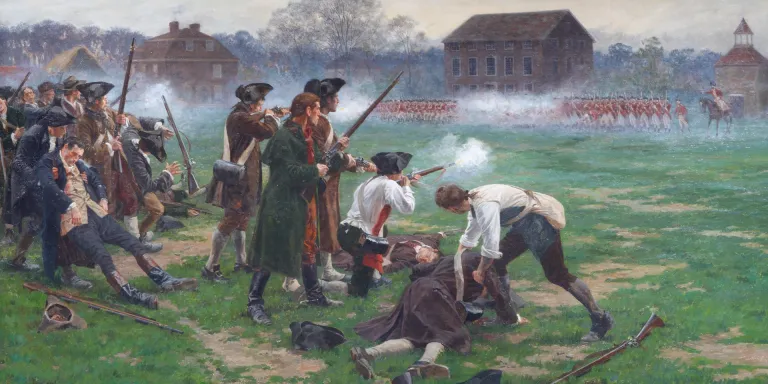
The Battle of Lexington, 19 April 1775
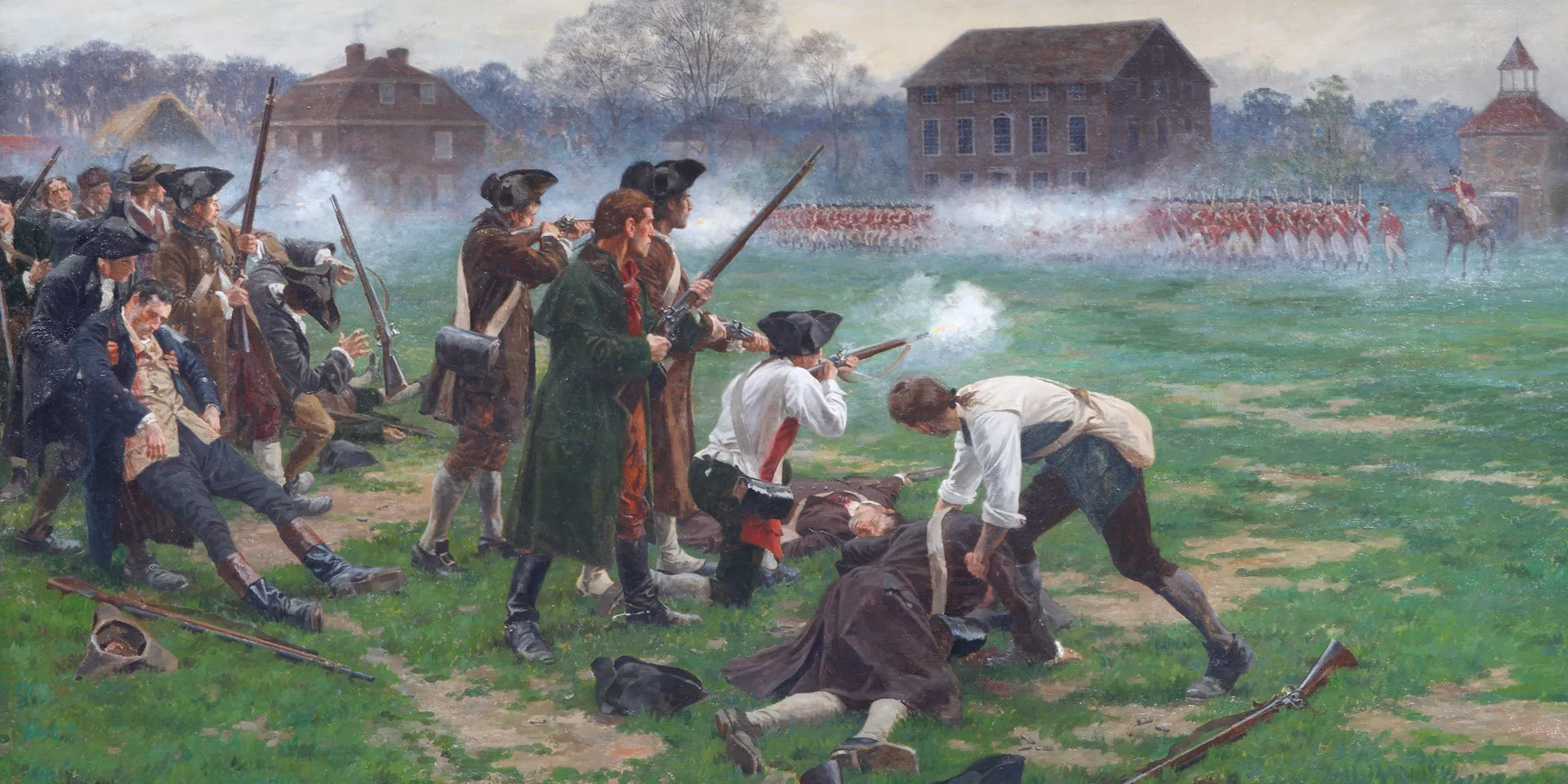
The context
Britain’s 13 American colonies were founded in the 17th and early 18th centuries. They ran along the eastern coastline from Massachusetts in the north to Georgia in the south. Most of the colonists were doing well as the American economy was thriving. They had the highest standard of living and lowest taxes in the western world.
Each colony was administered by a royal governor, his council and an elective colonial assembly. The governors also controlled the troops in their colonies. These policed the towns and ports and defended the settlers from border attacks by Native Americans and the French.
British victory in the Seven Years War (1756-63) sowed the seeds of the American revolt. It freed the colonists from the need for protection against the French threat on their frontier. It also gave free rein to the forces working for independence.
The British wanted to increase taxes and make the colonies pay for their defence. The colonists argued that only their own assemblies, and not the British parliament, had a right to levy taxes.
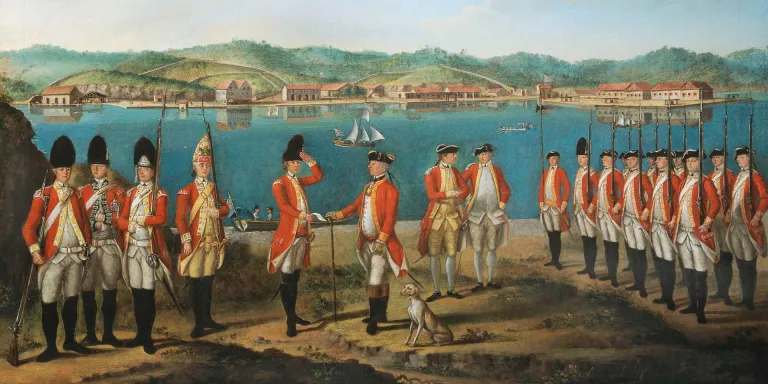
British redcoats, c1771
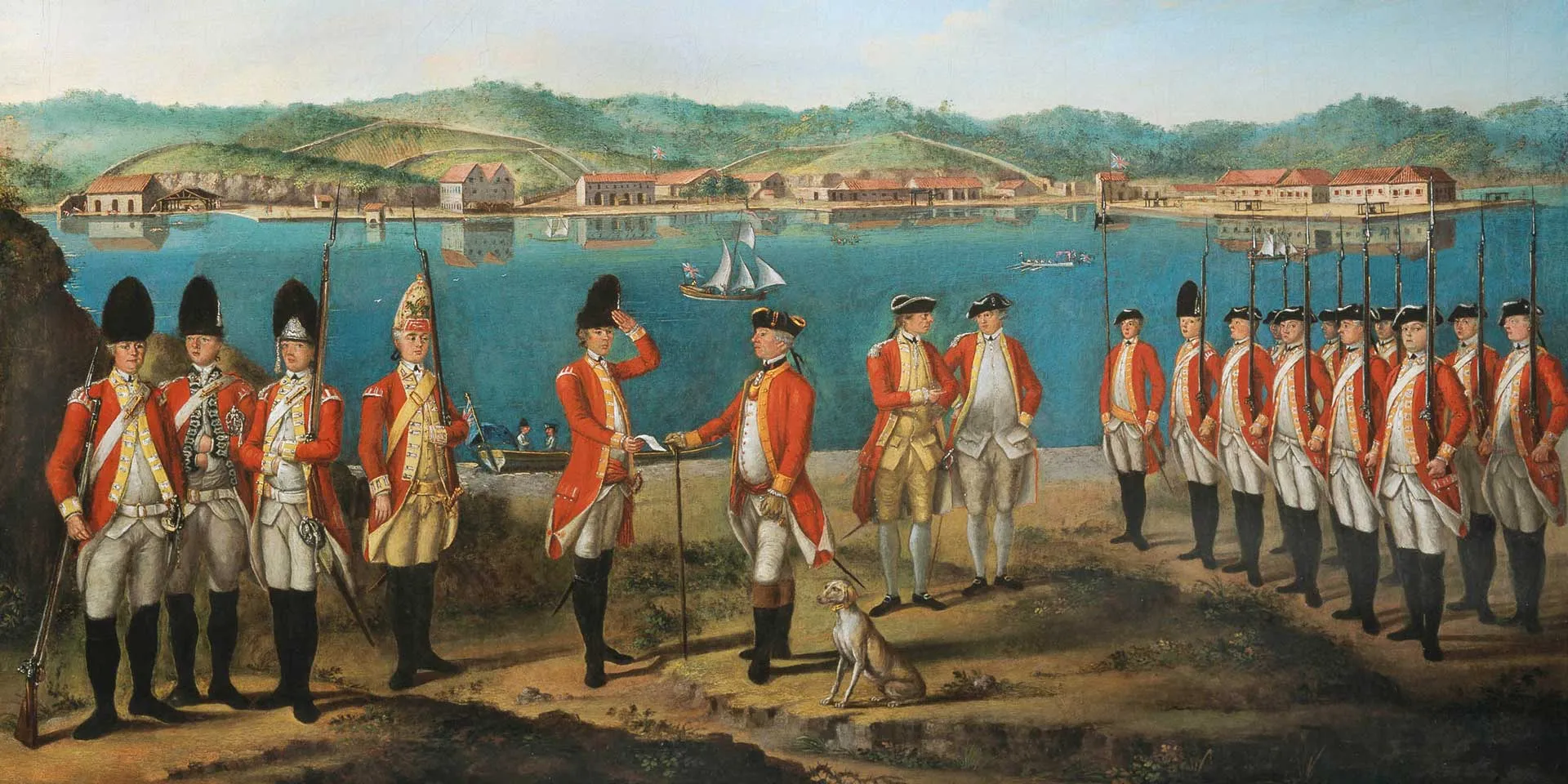
Boston Tea Party
In December 1773 the colonists dumped a cargo of British tea into Boston harbour in protest at the Crown's attempt to tax imports. In response to the ‘Boston Tea Party’, the government introduced a series of measures known as 'Intolerable Acts'.
They closed the port of Boston, dissolved the colonial assembly and placed Massachusetts under military rule and the command of Major-General Thomas Gage.
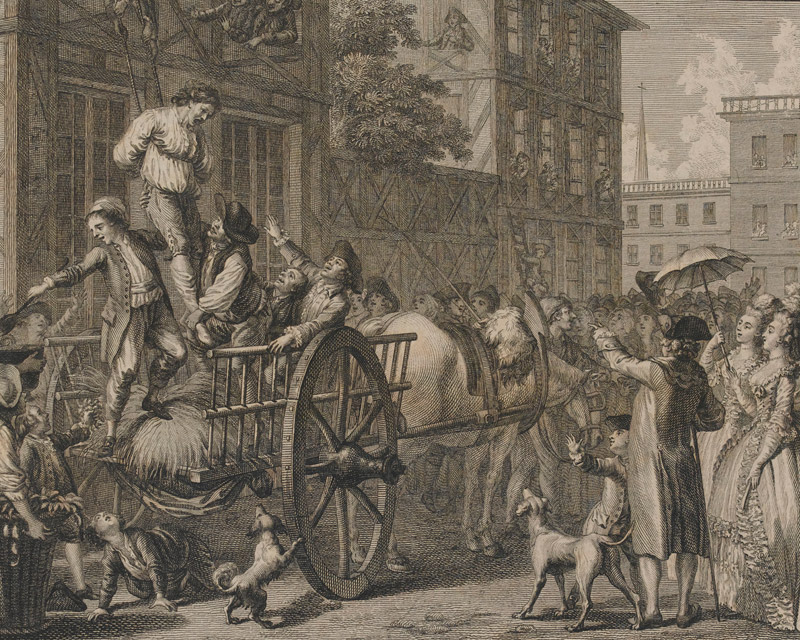
John Malcolm, a British customs officer captured by the Boston mob, January 1774
Prosperity and liberty
Until this time, the colonies had been allowed to develop with little interference. But now London was attempting to tighten its political control. Many colonists were convinced that their economic prosperity and liberty were at stake. As the dispute continued, they gradually took over the local militias and started arming and drilling.
Acting on intelligence that the militia were stockpiling weapons, Gage ordered Lieutenant-Colonel Francis Smith to march to Concord and seize the arms.
On 19 April 1775 Smith encountered militiamen at Lexington Green. The latter had been forewarned about British plans and had quickly mobilised.
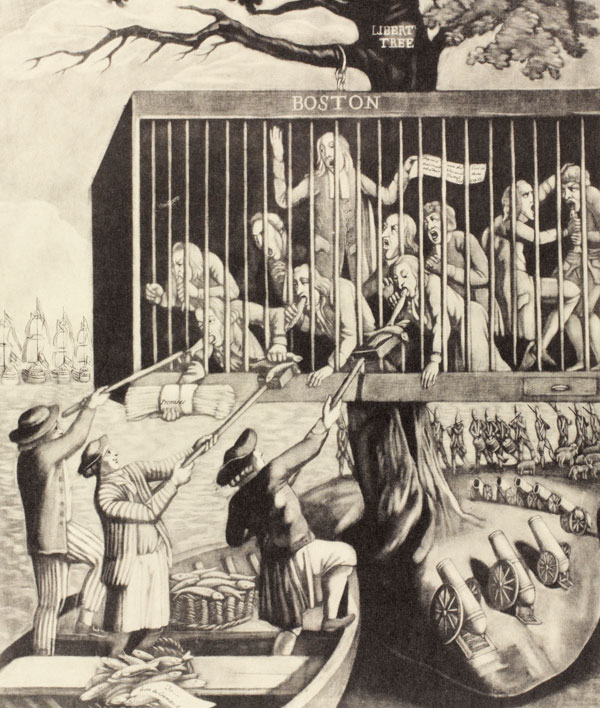
This cartoon, entitled ‘The Bostonians in Distress‘, symbolises the closing of the port by placing its inhabitants in a cage suspended from the Liberty Tree, c1774
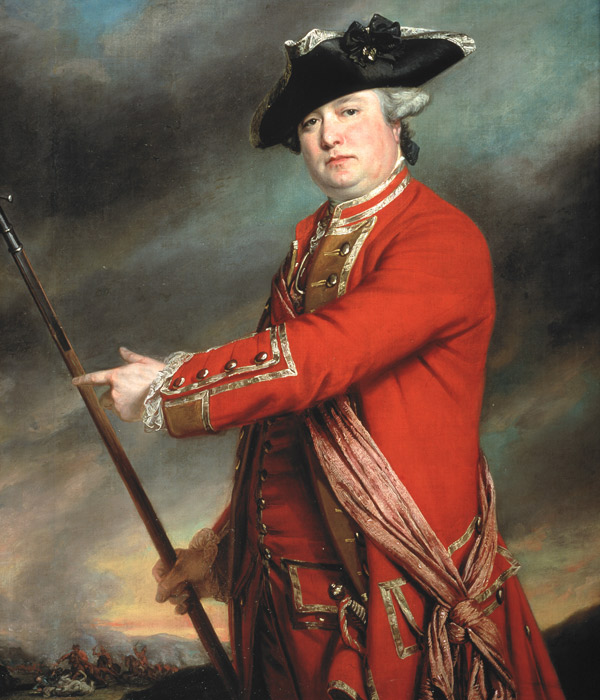
Lieutenant Colonel Francis Smith, 10th Regiment of Foot, 1764
In 1775 there were about 7,000 British redcoats in America, with around 4,000 in Massachusetts itself.
Lieutenant-Colonel Francis Smith (1723-91) commanded the 800-strong force, drawn from several regiments, that was sent to seize the arms. An officer with 12 years’ colonial experience, Smith had served in America since 1767.
Most of the militiamen were farmers or tradesmen, including the commander of the Lexington militia, John Parker (1729-75). He had fought for the British during the Seven Years War at Louisburg (1758) and Quebec (1759).
Non-uniformed, they were armed with a variety of firearms including muskets and fowling pieces.
Most militiamen served for only a few months at a time and were unavailable for lengthy operations. Their best soldiers were the 'minute men’, militia who had undertaken to turn out at a minute's notice. Quick-moving, they were better suited to irregular warfare and skirmishing than European-style military manoeuvring in formation.
Around 80 militiamen were present on Lexington Green and around 500, commanded by Colonel James Barrett (1710-79), were at Concord. At least 3,500 were present by the time the British returned to Boston.
After being warned of opposition on the road ahead, Smith ordered his light infantry, under Major John Pitcairn, to move forward while he stayed with the main body of troops.
Pitcairn's men encountered about 80 militiamen under John Parker in parade-ground formation. Parker knew he was outnumbered, but probably thought violence could be avoided. He was putting on a show of political strength rather than placing his men in fighting position.
Pitcairn called on the militia to disperse. But just as this was about to happen, shooting broke out. It is unclear who fired the first shot - both sides had given orders not to fire - but eventually the British discharged a volley and charged with fixed bayonets. Eight militiamen were killed and ten wounded. One redcoat was injured.
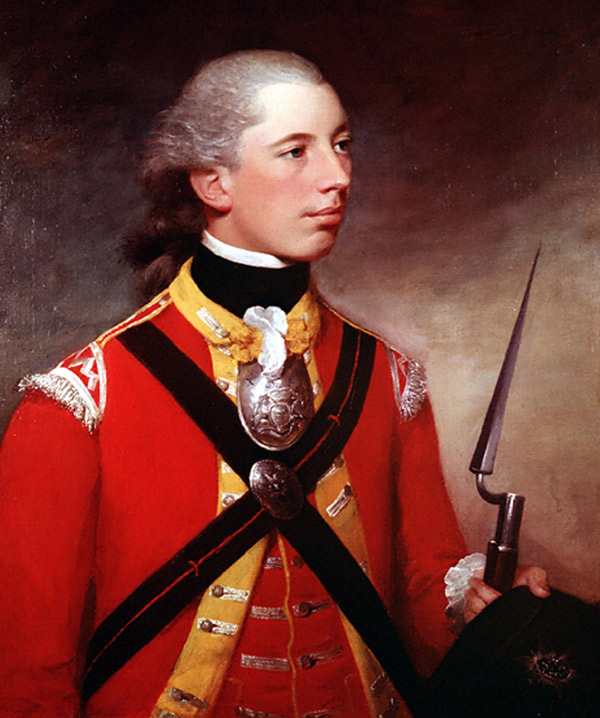
Captain Thomas Hewitt, 10th Regiment of Foot, who commanded a light company at Lexington, 1781
North Bridge
Smith arrived soon after to find Pitcairn’s troops scattered and pursuing the retreating militiamen. After restoring order and reforming his light infantry, he pushed on to Concord.
Rather than fight in Concord itself, the rebels withdrew to North Bridge. While the British fruitlessly searched the town for arms, the rebels awaited reinforcements there.
Some hours later there was a second skirmish between 90 light infantrymen sent to secure the bridge and around 500 militiamen led by Barrett. Finding themselves outnumbered and outmanoeuvred, the light infantry retreated back to the town having suffered several casualties.
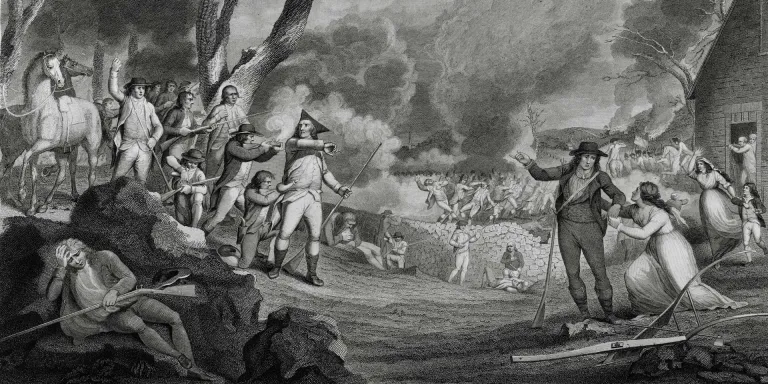
On hearing gunfire, Smith marched his men towards the bridge where there was a tense stand-off before the British withdrew towards Boston. However, they were caught by the arrival of more American reinforcements and pressured into a fighting retreat.
The militia’s early warning system was crucial in assembling these men. They now had sufficient numbers to inflict heavy damage on the British.
Smith’s force was repeatedly ambushed and sniped at as it withdrew along the roads to Boston. Several officers were killed or wounded as Smith struggled to maintain control. His men lost discipline and hurried onwards in a general retreat.
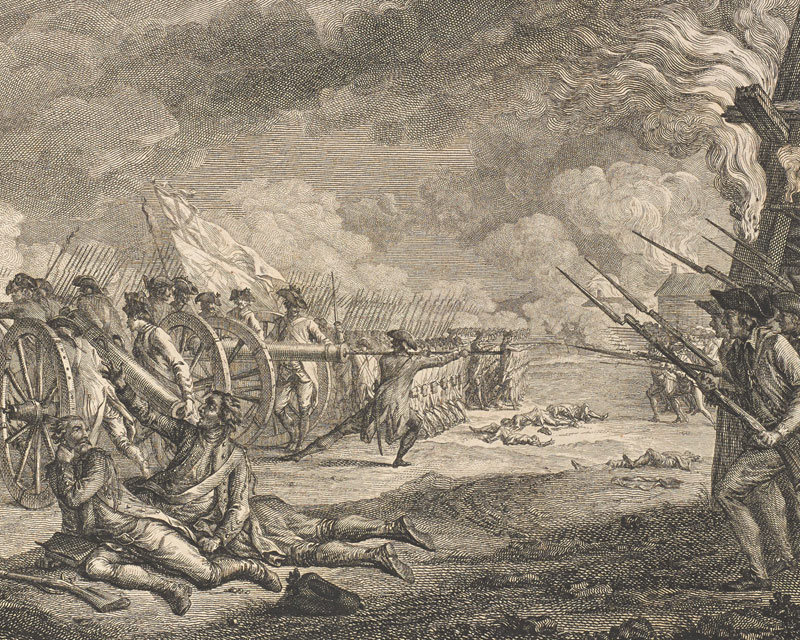
This French print shows British troops fleeing from the American militia, 1775
Reinforcements
By the time it reached Lexington, the column was near collapse. A brigade of British reinforcements, under Brigadier-General Hugh Percy, was waiting there.
After dispersing the pursuing militia with artillery, Percy covered the retreat back to Boston. During the journey the militia repeatedly fired upon the 1,700-strong force, but Percy’s well-planned defensive formations fought them off.
Many of the British had not slept for two days and had marched 40 miles (64km) in 21 hours, much of it under fire. The casualties sustained during the retreat, from an often-unseen enemy, along with the alleged scalping of a redcoat, led them to commit atrocities against the locals.
During the retreat the British lost 73 killed, 173 wounded and 26 missing. American losses were 50 killed, 39 wounded and five missing. Within two days 15,000 men from across New England had assembled and surrounded the British in Boston.
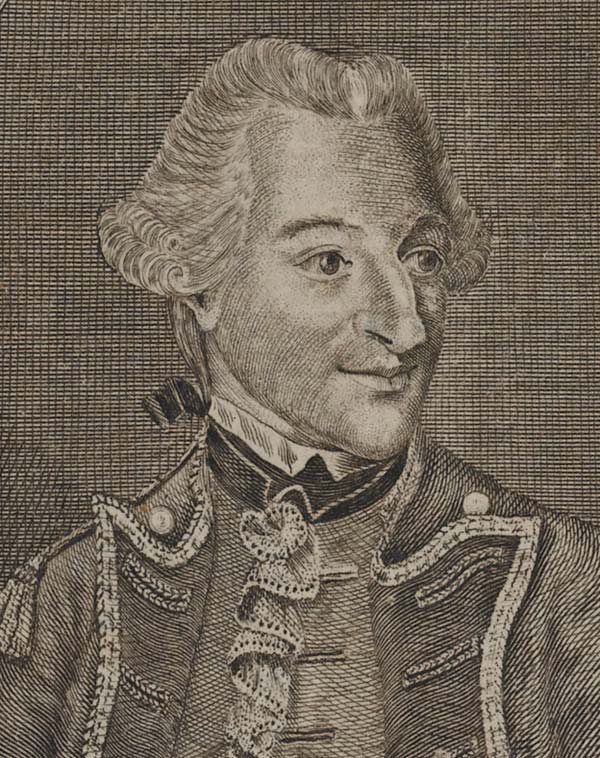
Brigadier Hugh Percy, c1768
The consequences
Lexington was not a serious military defeat, but it was politically disastrous for the British. Smith’s expedition managed to seize few weapons and caused the very fighting it was intended to prevent. The violence turned a colonial revolt against British policy into a fight for political independence .
Lexington and Concord led many Americans to support the 'revolution'. For John Adams, these battles were the moment ‘the Die was cast, the Rubicon crossed’. They also showed that American citizen soldiers could stand up to redcoats; something previously doubted by many on both sides.
Newly emboldened, the Americans laid siege to Boston. The British position there was fairly secure once reinforcements arrived at the end of May 1775. They were, however, continually menaced by fire from the surrounding hilltops.
To counter this, on 17 June British troops were ferried across to Breed’s Hill on the Charlestown Peninsula. Here, at a cost of more than 1,000 casualties, they defeated the revolutionaries at Bunker Hill, the first major battle of the American War of Independence .
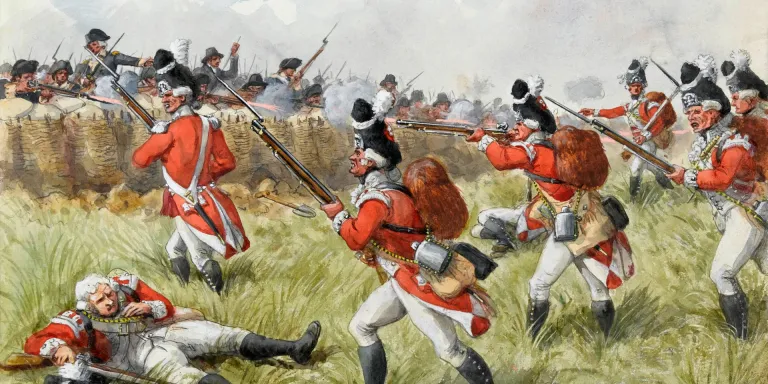
The Battle of Bunker Hill, June 1775
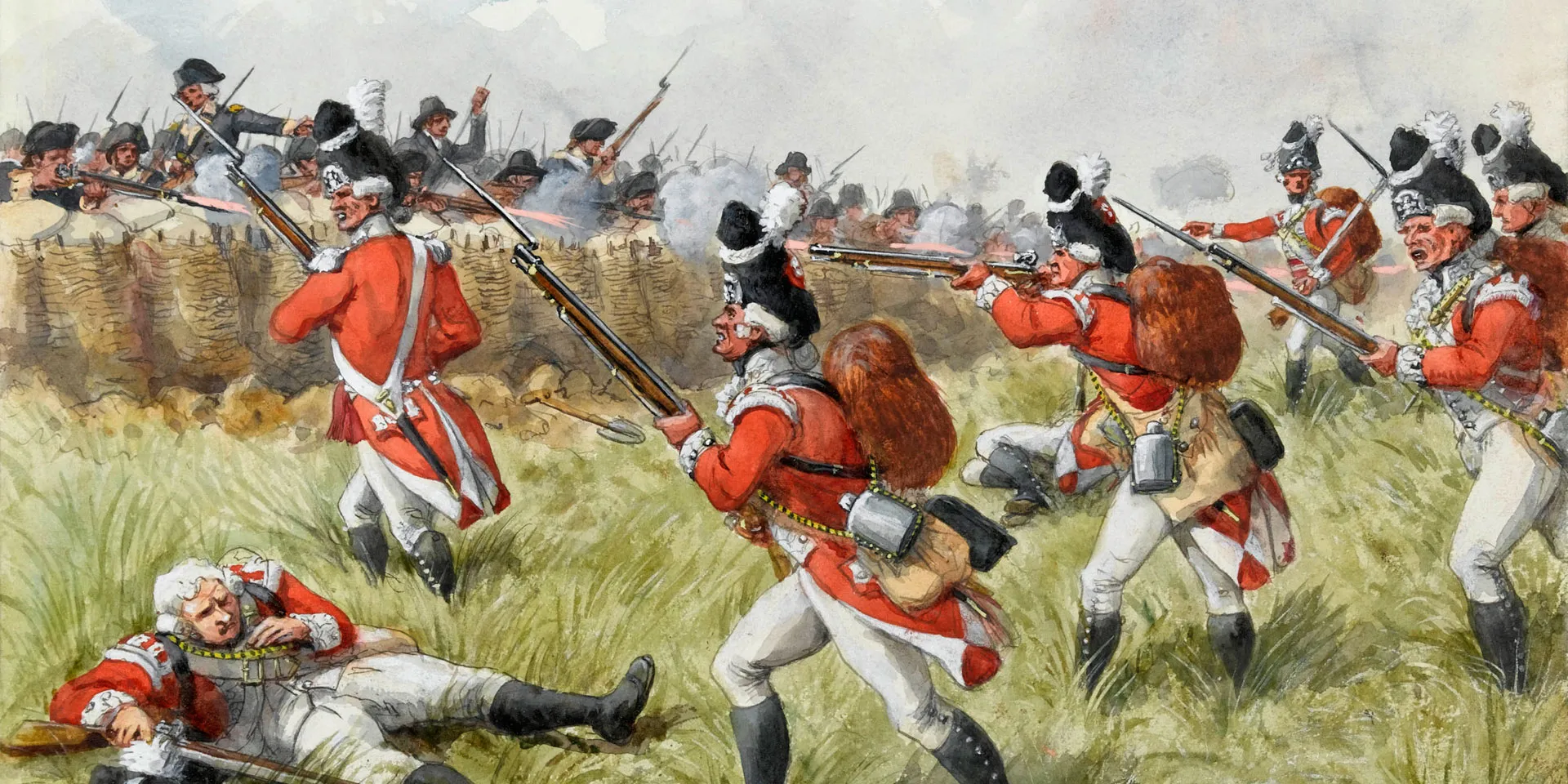
Lexington and Concord started a war that resulted in Britain losing her American colonies. Unsurprisingly, these battles were conveniently forgotten in Britain. However, they soon became vital parts of the foundation story of the United States.
For years afterwards they were portrayed as British attacks on innocent freedom-loving Americans. Many of the truths about the battles, such as who fired first and the importance of the militia preparations, were ignored.
Their status was elevated in Ralph Waldo Emerson’s ‘Concord Hymn’ (1837). First read at Concord on 4 July 1837, his poem, which includes the famous line ‘the shot heard ‘round the world’, became central to the mythology of the American Revolution.
Explore further
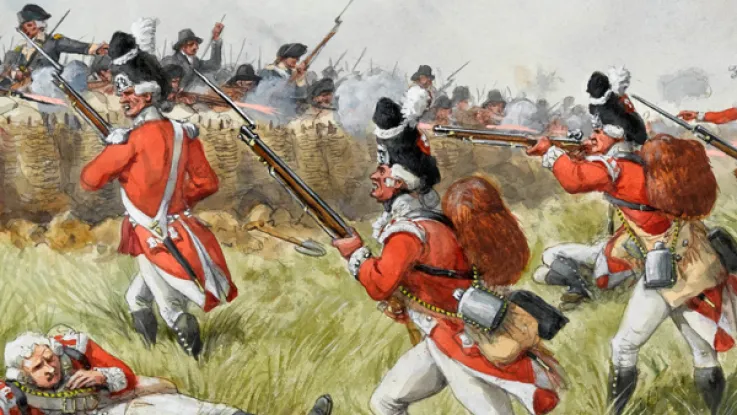
American War of Independence: Outbreak
In 1775, political and economic concerns led the inhabitants of Britain’s 13 American colonies to rise up in revolt. The subsequent conflict divided families and communities across North America.
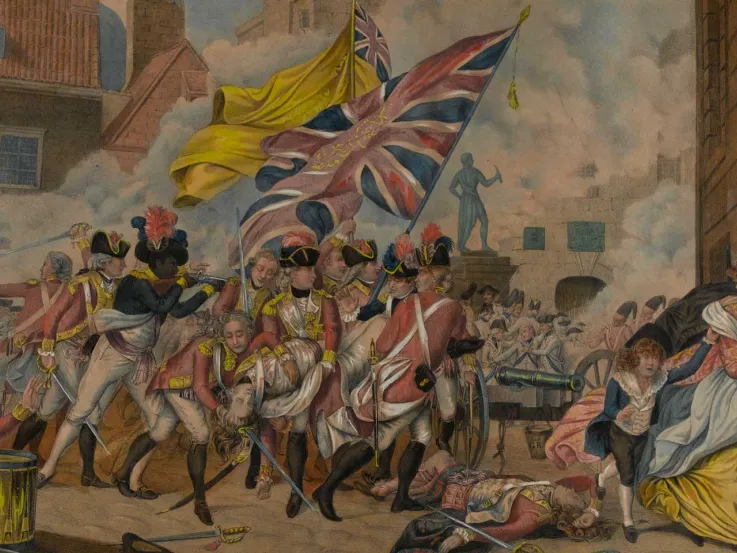
American War of Independence: Key battles
In 1775, Britain’s American colonies rebelled in a bid for independence. The British Army performed fairly well in battle against the rebels, but it was unable to prevent the loss of territory following French and Spanish entry into the war.
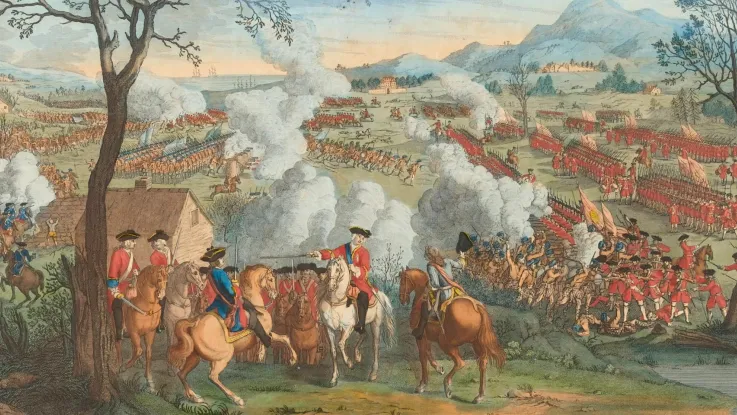
Battle of Culloden
The Battle of Culloden, the climax of the Jacobite Rising of 1745, was fought near Inverness on 16 April 1746. It finally settled a contest for the British monarchy that had lasted almost 60 years.
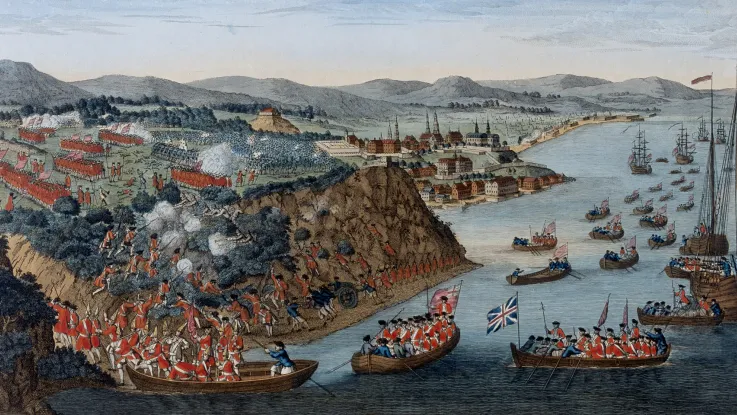
Battle of Quebec
The Battle of Quebec in 1759 was one of Britain's greatest victories of the Seven Years War (1756-63). Major-General James Wolfe’s triumph ultimately led to the British conquest of Canada.
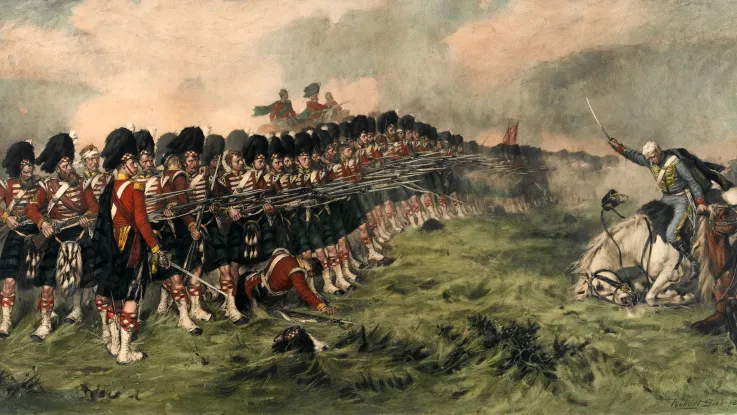
Battle of Balaklava
The Battle of Balaklava in 1854 witnessed one of the most famous acts of battlefield bravery and one of the most infamous blunders in military history.
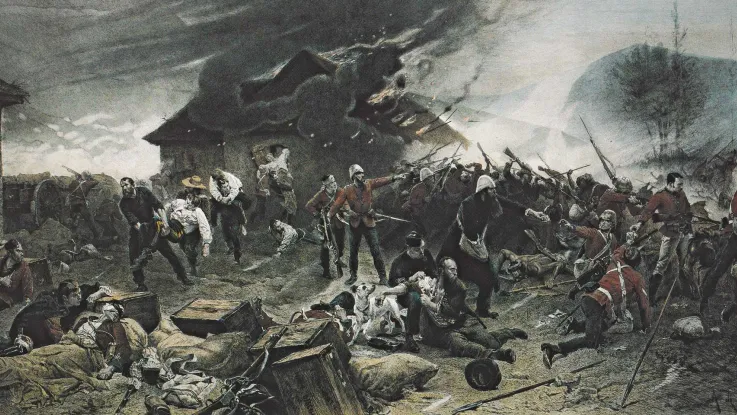
Defence of Rorke’s Drift
This battle took place on 22-23 January 1879. A huge force of Zulus attacked a small British garrison, but was eventually repelled after more than 12 hours of bitter fighting.
Join the conversation
"First time @NAM_London today. Thoroughly enjoyed it. Thought the presentation & interpretation made the subject accessible..."
Sign up to the National Army Museum newsletter
Be the first to hear about our latest events, exhibitions and offers. Simply enter your email address below to start receiving our monthly email newsletter.
To find out more about how we collect, store and use your personal information, read our Privacy Policy .
- About the museum
- Get involved
- Donate online
- Birthday Parties
- Templer Study Centre
- Picture Library
- Museums liaison
- Museums training programme
- Regimental and Corps Museum networks
- Terms of use
- Privacy and cookies
- Accessibility
National Army Museum, Royal Hospital Road, London, SW3 4HT Registered Charity Number: 237902

Visitor's Guide to Lexington and Concord
F or the American history fan, the cities of Lexington and Concord are on the bucket list. Most well known as the locations which saw the first shots of a revolution, they also were the home of America’s greatest minds as well. The breadth of the history available to those who come to Lexington and Concord is vast. Enjoy war history? This is the place to come. Enjoy great American authors? This is the place to come. Enjoy quaint American towns? This is the place to come. It’s got pretty much everything for everyone, including you
Minute Man National Park
Depending on how you arrive in the area, traveling to Minute Man National Park may take you through Lexington. For us, we settled on the quicker highway route and ended up at Minute Man first on our travels. After parking, the visitors center is a pleasant walk through the woods and a clearing. Beyond this pleasant little walk, the visitor center is packed with great historical information and guidance to the area.
When you first go in, I encourage you to watch the short presentation. It runs nearly continuously during the day and give you a great introduction to the battles of Lexington and Concord. The production has that wonderfully quaint quality that you seem to find only at state or national parks.
The Old North Bridge over the Concord River
Beyond the visitor center, the park stretches out along the road. You can stop and visit places like Paul Revere’s capture site, many of the still existing homes along the way, or Hartwell Tavern. In fact, for the ambitious among you its possible to even hike the entirety of the “Battle Road”. This trail runs through the park and follows the route that the British and Colonials fought along from Concord to Boston.
The Old North Bridge
The Old North Bridge has its own visitor center and beautiful grounds. We took the opportunity to have a picnic lunch here and enjoy the gorgeous fall weather. From the Visitor Center you’ll be able to see the Concord River and the bridge itself.
While the Old North Bridge is no longer the original, standing on the side the Colonials defended can truly put you back in time. Its easy to imagine standing upon that bridge, preparing yourself for a fight and not knowing the outcome. I stood there and wondered if those men understood just what had begun.
Home to Hawthorne and Emerson
Just across the Old North Bridge lies The Old Manse . This home not only bore witness to the first shots of the Revolution, but served as the home for some of America’s greatest minds. The grounds also provided me with one of my favorite pictures from this trip. It has a small dock on the Concord River which you can access and even launch a kayak from. I used it to grab a perfect image of the bridge over the calm waters of the Concord.
Homes of Great American Minds
Boston and the towns surrounding it have served as the home for many of America’s greatest writers and thinkers. During the time of the revolution it was men such as John Hancock, Sam Adams, and others who lived on this land. In later years this area served as the inspiration for Henry David Thoreau, Nathaniel Hawthorne, Louisa May Alcott and Ralph Waldo Emerson.
It is these later authors who still have a great impact on the area. They were all contemporaries in some fashion, and in many cases, they actually lived in or spent time in the homes of each other. These homes are some of the best attractions in the area. Most are preserved and able to be appreciated in much the same state as when they were last lived in.
Louisa May Alcott’s Orchard House was preparing for their 150th anniversary
The three most prominent are the Wayside, the Orchard House, and the Old Manse. Wayside and Orchard House are next to each other, a simple walk down the road. The Old Manse is a bit further away, but has a history linked with that of the American Revolution. Though I wished to tour all three, our timing meant that we only took the guided tour of the Orchard House.
For any fan of Little Women , the Orchard House is a must. Of all the things to do near Boston, this was the one my wife insisted we do. I’m quite happy we did because the guided tour was so full of great information about Louisa and the Alcotts. Fans of the book will be able to link many of the locations to this house and its items as well. I enjoyed the brief look into life back then and the connections the Alcotts had to the great minds of the day.
The Towns of Lexington and Concord
The towns of Lexington and Concord are precisely what you would picture a small New England Town to look like. Both are fairly compact and filled with small shops and local eateries. Concord’s location near the Old North Bridge, Old Manse, and many of the other homes in the area means you might not spend much time in Concord proper. Even with all the time we spent nearby, we still didn’t get a chance to visit Walden Pond, the Concord Museum or Sleepy Hallow Cemetery.
Memorial at the Lexington Battle Green
I did make sure to have us stop for a bit in Lexington. Unlike Concord, the City of Lexington and its associated battle took place in what is now the heart of the town. The Lexington Common, where the battle took place, is open and accessible. It was a surreal feeling to know that I stood where the first blood in the revolution was spilled. However, unlike the Freedom Trail, the overwhelming push of time didn’t feel so apparent. You could stand in the center of that green and imagine the Minutemen exiting Buckman Tavern across the way to meet the oncoming British.
While there are fewer sites to explore in Lexington, both of the towns offer plenty to those in love with history. There is simply so much which surrounds them and that they contain. It felt easier to become connected to the past in these two towns than it did surrounded by all that modern Boston offers. No trip to Boston can be complete without taking time to visit Lexington and Concord.
An Eye Towards History in Lexington and Concord
As one of the major parts of my “ heritage tourism ” experience while in Boston, these cities didn’t disappoint. Neither of them pretend that they are something they are not. The history they offer isn’t hidden away from your eyes, but something proudly displayed. When you travel here, you’ll need to come with an eye towards experiencing and enjoying that history. It lies in so many little nooks and crannies, yet also in the woods and open spaces that surround you.
Lexington and Concord were some of my favorite parts of my trip to Boston. If you’ve enjoyed reading this, then check out my time in Salem . If you’ve only got one day in Boston , then I’ve got a guide for that too! Want to follow along with my travels live? Then check out my Facebook for updates and “micro-blogs” or Instagram for daily photos! Subscribe to my blog today and get updates as soon as they post!
Don’t forget to pin by using the images below!
The post Lexington and Concord: In the Footsteps of Patriots appeared first on Florida Man on the Run .

Visitors Center is open daily at 9am-4pm.

- Visitors Center
- Restaurants
- Arts & Culture
- Partner Communities
- Add Your Business Listing
- Battle Green Tour
- Liberty Ride Trolley Tour
- Charter Tours
- Private Tours
- Itineraries
- Cultural District
- Submit an Event
- Lexington Patriots’ Day
- Getting Around
- Business Index
Tour the Battle of Lexington and Concord
March 13, 2024

The Battle of Lexington and Concord marked the first battle of the American Revolutionary War. Let’s talk more about the battle and the historic sites where key events took place.
When was the Battle of Lexington and Concord?
On the night of April 18, 1775, British troops marched from Boston to Concord to ruin the colonist’s plan of rebellion. However, Paul Revere and other riders were able to sound the alarm, warning residents that the British were coming. The actual battle took place on April 19, 1775, and spread out through both Lexington and Concord.

Who won the Battle of Lexington and Concord?
When the British troops marched into Lexington , they came face-to-face with a militia of 77 men. From there, a shot rang out (although it is a point of discussion on who fired the first shot). The British, in fear of these rebellious militia, marched on towards Concord. Once the British troops arrived in Concord, they were soon surrounded by 400 Minutemen from Concord and surrounding towns. The British troops then retreated to Boston, passing through Lexington again where vengeful Minutemen ambushed them.
After the Battle of Lexington and Concord, many Patriots swarmed to join the fight. In 1783, America finally won freedom from the British Monarchy.
Lexington Sites of the Battle of Lexington and Concord
For history buffs who are interested in seeing the locations where the actual battle took place, take a tour of Lexington’s memorable sites during that fateful day in 1775.
Hancock-Clarke House
John Hancock and Sam Adams were residing at Jonas Clarke’s home when Paul Revere arrived at midnight on April 19, 1775. This is when he said the famous words “The Regulars are out,” meaning that British troops were on their way. Now, the Hancock-Clarke House is operated by the Lexington Historical Society; visitors will discover period furnishings and portraits.
The house is closed for the season, set to reopen on April 6. Learn more information about their tours.

On April 19, 1775, The Belfry , on Lexington Battle Green, sounded the alarm that told the Lexington militia that the British were coming. Unfortunately, the original structure was destroyed by a hurricane in 1909. However, the Lexington Historical Society erected a replica in 1910. This bell rings every Patriots’ Day, commemorating all the colonists who fought the Battle of Lexington and Concord.
Buckman Tavern

On the morning of April 19, 1775, Captain Parker and his colonial militia gathered in the Buckman Tavern waiting for the British troops to arrive. This tavern is now a museum where visitors can view galleries.
Learn more information about touring the Buckman Tavern.
Lexington Battle Green
Lexington Battle Green is where the battle began, right in the early morning hours of April 19, 1775. Captain Parker lined up his Patriot men on this battleground as they watched the British soldiers marching toward them. About 77 men were a part of this militia that fought the British. The Lexington Battle Green grounds are viewable all year.
Munroe Tavern
When the British retreated to Boston after the Battle of Lexington, they took shelter in the Munroe Tavern . It operated as a temporary hospital and headquarters for British General Earl Percy and his 1,000 men. The Lexington Historical Society owns this tavern, but it is temporarily closed to the public for the season. Munroe Tavern will open its doors again starting April 6; learn more about how you can tour the historic tavern.
Learn More about the Battle of Lexington and Concord
If you’re interested in discovering more about the Battle of Lexington and Concord, take a trip to the Visitors Center , where you’ll find a full Diorama of the Battle of Lexington and Concord. Head to the Scottish Rite Masonic Museum where you’ll find texts like the Minuteman Newspaper. Sign up for a Battle Green Tour or Liberty Trolley Tour to get a full scope of Lexington’s historic monuments during the Battle of Lexington and Concord.
Unearth Lexington’s Revolutionary history and visit today!
Related Post

July 17, 2024
Lex250: Legacy in Lexington
With each month that passes, we get closer to Lex250, the 250th anniversary celebration of the Battle of Lexington which will take place in April 2025. Lexington has a meaningful…

July 10, 2024
Taste Lexington’s Cultural Cuisine
Lexington is home to many restaurants and different cuisines. Let your taste buds go on a journey and try these four restaurants on your next trip. Little India Express Little…

July 2, 2024
Lexington Celebrates July 4th
July 4 marks America’s Independence Day. Because this is a federal holiday, federal offices, state offices, banks, post offices, libraries, and certain retail stores are closed. However, there are still…
- Redeem Password

Battle of Lexington and Concord Self-Guided Driving Tour
Also includes walking tour.

Tour Details
Upgrade to bundles & save.

Action+ Annual Unlimited Subscription of 160+ Tours for $99.99 SAVE WITH BUNDLES $99.99

Massachusetts Self-Guided Driving and Walking Tours Bundle(12+ Tours) SAVE WITH BUNDLES $150.88 $39.99

East Coast Fall Foliage Self-Guided Driving & Walking Tours Bundle(20+ Tours) SAVE WITH BUNDLES $229.99 $74.99
Welcome to the battle of lexington and concord tour.
Discover the thrilling events behind the “shot heard ‘round the world” with this self-guided driving and walking tour through Lexington and Concord. Follow the path of the very first battle of the American Revolutionary War, from a shootout in the town square to a life-or-death struggle on a narrow bridge. Step back in time and witness the courage and ferocity of the minute men who took on the greatest military power in the world.
About the Tour
Your journey begins at the North Bridge, where the most pivotal moment of the entire battle took place. Here, you’ll get the background on what set the stage for this conflict, and why the Americans thought the British were already burning Lexington!
Then you’ll dive right into the thick of things and hear about the first major engagement between British and American forces, including the famous “shot heard ‘round the world.” See how the tide of battle swung against the British, and watch their desperate retreat.
Next, you’ll get to know American Major John Buttrick and enter the center of Concord. As you admire the historic surroundings, listen to striking accounts of how things went from bad to worse for the redcoats.
You’ll follow the route of the action alongside Battle Road, bringing skirmish after skirmish to life as the British soldiers make their arduous, bloody trek toward the safety of Boston. Watch the American militiamen force the British into one trap after another in one of the most unlikely upsets in battlefield history.
After that, you’ll stop by the site where Paul Revere was captured. Here, you’ll get the facts about his often misunderstood Midnight Ride, and hear about who, exactly, the Minute Men were, and how they were able to fight off the British Empire.
Finally, you’ll end up where it all began: Lexington. Witness the final, tense sequence of the battle play out here, then hear about the earth shaking aftermath of the dramatic encounter.
Upgrade and Save:
Upgrade to one of the below bundles and get the best value for your money!
- Massachusetts Bundle: Enjoy 12+ self-guided driving and walking tours in Massachusetts for $39.99 per person and save 73%.
- East Coast Fall Foliage: Immerse yourself in 20+ self-guided driving and walking tours for $74.99 and save 67%.
Want all of our tours? Upgrade to Action+ :
- An annual $99.99/year subscription offers access to over 160+ tours.
- Unlimited use throughout the year.
- Includes free access to new tours as they are released.
Lexington Map
Where To Start?
Starting Point Address: North Bridge Visitor Center, 174 Liberty St, Concord, MA 01742, USA
How Does It Work?
- Once you book a tour, you’ll get a text/email with instructions.
- Download the app (while in good wifi/signal) and use your unique password to access your tours. If there are multiple versions or entrances for your tour, be sure to download all audio guides.
- To begin touring, go to the starting point and launch the app.
- The audio starts automatically once you reach the starting point. Stick to the tour route and speed limit for the best experience.
- Please note that no one will meet you at the starting point.
What You'll See
Welcome:north bridge visitor center & buttrick mansion.
The North Bridge Visitor Center, situated at 174 Liberty St. in Concord, MA, occupies a historic brick mansion constructed in 1911 by descendants of the Buttrick family. Major John Buttrick, a colonial officer, famously commanded his militia to open fire on British soldiers during the pivotal North Bridge fight. At the North Bridge Visitor Center, visitors can enjoy a brief video about this significant event, explore a bookstore, and view engaging exhibits.
Meriam's Corner
Once you’ve parked, pick up the Battle Road Trail trail at the end of the lot farthest from the entrance. Once you walk a few hundred feet, you’ll come to Meriam’s Corner. It might not look like much, but this was the site of a disaster for the British.
Paul Revere Capture Site
This is the site where Paul Revere was captured, and a great opportunity to reflect on how the British ended up in such a predicament. Remember, their mission to confiscate weapons was supposed to be secret.
Lexington Common National Historic Site/Conclusion
The Battles of Lexington and Concord left 73 British dead and 174 wounded. 49 Americans died and 39 were wounded. But the aftershocks of the battle went far deeper than that. The American victory was all the proof the colonists needed that they could win a war against Britain.
Ralph Waldo Emerson House
Almost in the Concord Museum’s backyard, you can find the former home of Ralph Waldo Emerson.

Concord Museum
This museum’s collection explores the area’s revolutionary and literary history. If you want to learn more about the town and see some unique artifacts, be sure to stop by!
Authors Ridge
Many famous authors lived in Concord, and several found their final resting place here in Authors Ridge. Thoreau, Alcott family members, Emerson, Nathaniel, and Sophie Hawthorne, and others are buried there.
Louisa May Alcott's Orchard House
This 1650 house is where Alcott wrote Little Women in 1868. At Orchard house, you can learn about Louisa May and the rest of her family, who were known for their commitments to abolition, women’s suffrage, and social reform.
The Wayside Home of Authors
The Wayside, built-in 1700, became home to several of these famous figures. The Alcotts bought the house in 1845, naming it Hillside. The experiences of the Alcott sisters in the home were later written into her classic Little Women.
Walden Pond and Thoreau Cabin Site
Just a mile outside of town, off Walden Street, is another site of literary history -- Walden Pond. This is where Thoreau lived for two years beginning in 1845, in a cabin he built, collecting his thoughts for his 1854 classic on self-reliance, Walden, or Life in the Woods.
Samuel Hartwell House
Just ahead on the left is what remains of the home of Ephriam and Elizabeth’s son Samuel. Samuel was a sergeant in the Lincoln Minute Men on April 19 and saw action up to and down the road. His wife Mary is said to have helped bury dead British soldiers.
Josiah Nelson House Site & Battle Road Trail
At the far end of the visitor’s center parking lot is a path leading to Battle Road Trail, which runs the length of Minute Man park. It follows what remains of the original Bay Road, which is the route the British took to Concord and back. It passes many historic sites.
Preview The Tour
is lexington ma worth visiting.
Yes, Lexington, MA, is worth visiting for its rich historical significance as the site of the first battle of the American Revolutionary War, its charming New England character, and its historic landmarks.
What is Lexington known for?
Lexington is known for being the site of the Battle of Lexington, which marked the beginning of the American Revolutionary War on April 19, 1775. It’s also known for its historical monuments and role in American history.
How do I spend a day in Lexington?
Spend a day in Lexington by visiting the Battle Green, where the Battle of Lexington took place, exploring historic houses and museums, enjoying local shops and eateries, and learning about the town’s role in the American Revolution.
Is Lexington MA cheap?
Lexington, like many New England towns, can have a higher cost of living. However, the experience of visiting historic sites and museums may be worth the investment.
Is Boston a cheap city?
Boston is known for having a higher cost of living. While there are affordable options, it’s generally not considered a cheap city to visit.
Is Lexington a city or town in Massachusetts?
Lexington is a town located in Middlesex County, Massachusetts.
Is it worth visiting Concord MA?
Yes, Concord, MA, is worth visiting for its historical significance, including the Battle of Concord, its literary heritage (home to authors like Louisa May Alcott), and its picturesque New England charm.
Where is Lexington and Concord battlefields?
The Lexington and Concord battlefields are located in Massachusetts, near Boston. Lexington’s Battle Green and Concord’s North Bridge area are key sites associated with the battles.
How to get from Boston to Lexington Concord?
You can get from Boston to Lexington and Concord by car, public transportation (such as the MBTA commuter rail), or by joining guided tours that provide transportation.
Who shot the first shot at the Battle of Lexington?
The exact identity of the person who fired the first shot at the Battle of Lexington is not known. It’s a debated historical question, and the event marked the start of the American Revolutionary War.
Inclusions and Exclusions
Nearby tours.

Sending login info,please wait...
Sending info,please wait...
Sending register info,please wait...
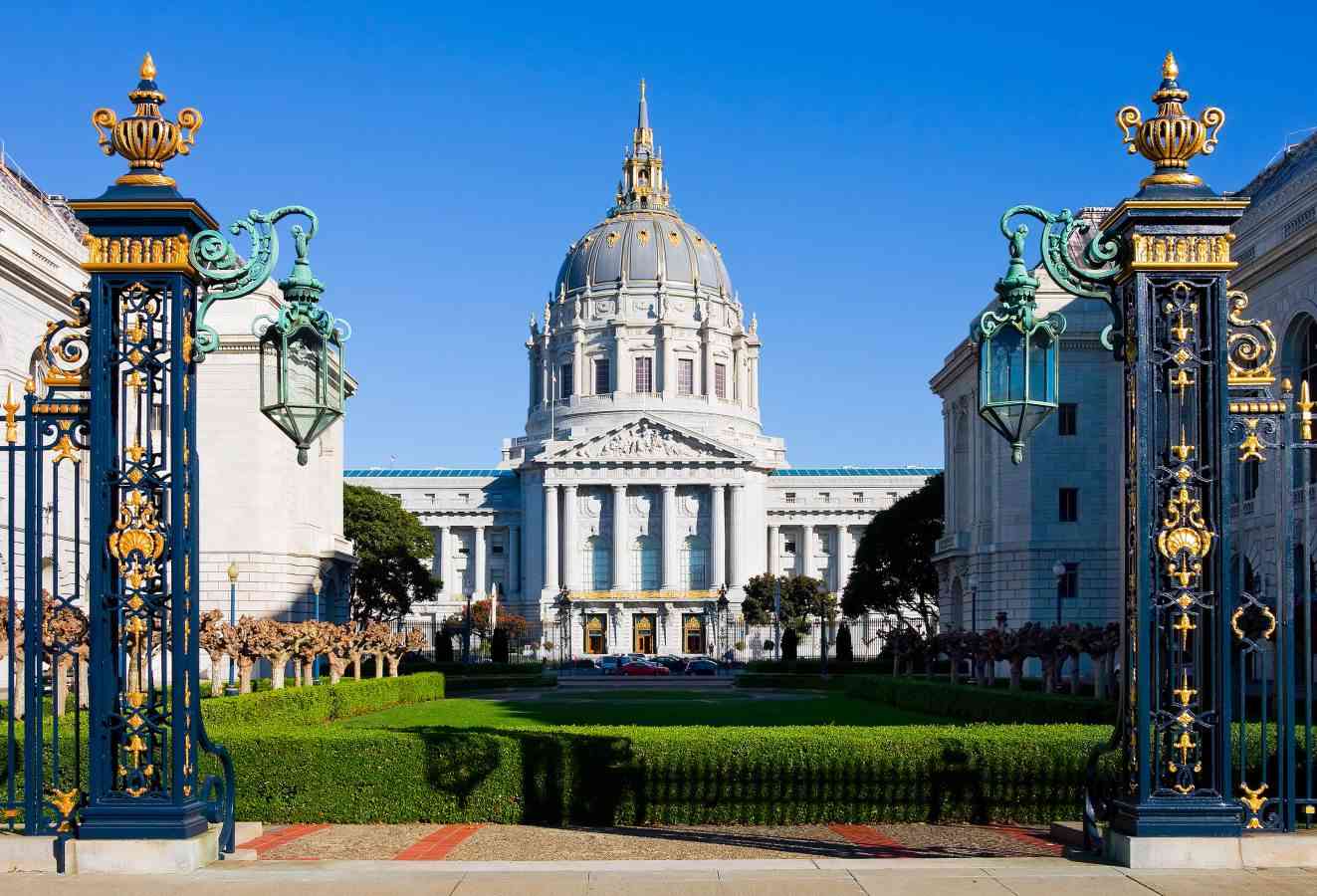
All tours are valid for a lifetime. Buy now, travel whenever—coupon code on the next screen. Subscribe to our newsletter below.

Know about new tour launches, get exclusive access to sales and much more. Subscribe to our newsletter below—coupon code on the next screen.
10 Facts: The Battles of Lexington and Concord
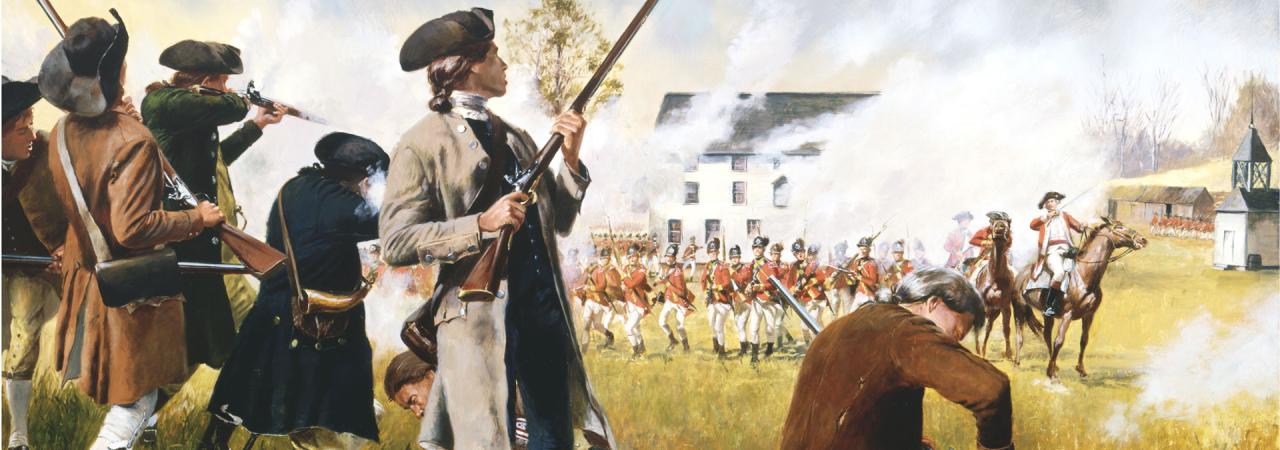
“Stand Your Guard,” a National Guard Heritage Painting by Don Troiani depicting the Battle of Lexington and Concord.
Fact #1: Minutemen vs. Militia
The most prevalent stories around Lexington and Concord is that of the “Minutemen.” If one visits Lexington and Concord today they will not only come across monuments to the Minutemen but also the National Park that commemorates the actions of April 19, 1775, is called Minute Man National Historical Park . Minuteman companies were officially created by the Massachusetts Provincial Congress in October 1774 to be the best soldiers of each militia company. They regularly trained, and some were paid. They were to respond, “at a minute’s notice.” Other colonies also adopted similar units naming them “training bands” or “minutemen.” On April 19, 1775 thousands of militia units responded to the alarm in Lexington and Concord from across New England. Despite the modern-day perception, the vast majority of the men who responded were not minutemen, but regular militia. Lexington, where today a monument to the Minutemen sits on the Battle Green, never created a Minuteman company. It was militia that met the British Regulars on the early morning of April 19, 1775.
Fact #2: Lexington was not the first place colonial militia and British Regulars faced off.
The events of April 19, 1775 were a culmination of many altercations between local militia and British Regular soldiers. On December 14 and 15, 1774, militia from Portsmouth, New Hampshire attacked Fort William and Mary. The British fort was undermanned (less than ten soldiers) but would not surrender to the militia force of nearly 300 men. Fighting ensued and one British soldier was wounded, the garrison surrendered and over the two days gunpowder, firearms and 16 cannon were captured. Though shots were exchanged from colonial militia and British Regulars, it did not lead to war. The events have mostly been forgotten today.
Fact #3: More than Paul Revere, dozens of colonial riders rode out on April 18-19, 1775
Paul Revere ’s role in the events of April 18-19, 1775 is well documented in modern American literature. Revere, along with William Dawes, rode from Boston to Lexington to warn of the British Regulars march west. Many falsely believed the soldiers were on a mission to capture John Hancock and Samuel Adams . As Revere and Dawes rode towards Lexington, they handed off their message to other riders in the towns they rode through. Soon, dozens of riders were spreading the word as far away as New Hampshire and Connecticut by the end of the day. The network of information sharing was astounding and showed that colonial leaders were well organized. Though Revere is by far the most well-known rider that night, he was by far not the only one out that night spreading the word.
Fact #4: British General Thomas Gage’s goal was the military supplies in Concord, not John Hancock or Samuel Adams in Lexington.
The Sons of Liberty in Boston believed when British General Thomas Gage ordered the Regulars out towards Lexington that their mission was the capture of Samuel Adams and John Hancock. Adams and Hancock were seen as the leaders of Massachusetts colonial resistance. Adams, the passionate orator, and Hancock the financier worked together for a common goal. Many believed the King wanted both men captured and ordered Gage to capture them. Both men were in staying in Lexington on April 19, 1775, at the Hancock-Clarke House (Hancock himself had lived here briefly as a child). Gage’s mission for his Regulars was not the capture of the two Patriot leaders, but the weapons, supplies and cannons being stored in Concord by the Massachusetts Provincial Congress. The fact the road to Concord from Boston that Regulars took went through Lexington had nothing to do with the presence of Adams or Hancock.
Fact #5: The Lexington militia did not intend to fight the British Regulars.
The Lexington militiamen that filed onto the Lexington Green the morning of April 19, 1775, were there as a show of force, to remind British authorities that the colonists were armed and ready to defend themselves. Much like other militia units had shadowed other British Regular excursions (most notably at Salem, Massachusetts on February 26, 1775), the Lexington militia had no intention in getting into a firefight with the Regulars. Captain John Parker proved to be a steady leader of the militia that morning, he knew it would be suicide for his 80 men to take on the 400 well-trained British Regulars. The position of Parker’s men to the side of the road to Concord show that Parker had no intention of blocking their route to Concord. Post war accounts of Parkers words that morning have been exaggerated, but his actions and primary accounts of those who were there prove that Parker had no intention of getting into a battle that morning.
Fact #6: No one knows who fired the first shot at Lexington
One of the biggest mysteries of April 19, 1775, is who fired the first shot at Lexington. Both sides claimed the other side shot first, thus placing blame on their enemy for the bloodshed that ensued. It seems everyone interviewed after the events of April 19 th had a varied answer to this question. It is obvious confusion and chaos infringed on everyone’s view of the events. There is evidence that points to either a quick trigger by one of the men on the Lexington green or a spectator firing from behind a stone wall near Buckman’s Tavern. We will never know who fired the first shot, but it was a spark that lit a world war.
Fact #7: The bloodiest stretch of “Battle Road” was in Menotomy.
Nearly 130 colonial militiamen and Regulars were killed on April 19, 1775. The fighting along the “Battle Road” grew bloody as the Regulars marched from Concord towards Lexington and back to Boston. But the bloodiest and fiercest fighting took place in Menotomy (modern-day Arlington) along modern-day Massachusetts Avenue. Here the fighting became hand to hand and brutal. Harassed for miles, British soldiers began to go house to house clearing families from the buildings along the road. In the fighting in this stretch, nearly 25 colonists and 40 British regulars were killed, half the day’s death count.
Fact #8: Despite modern-day pop culture references, there is no evidence to suggest that General Gage’s wife, Margaret Kemble Gage, was a spy for the Sons of Liberty.
One of the mysteries surrounding the events in Boston in the spring of 1775 is how Joseph Warren and the Sons of Liberty were able to gather such top secret information on the British military in Boston. Warren, John Hancock, Sam Adams, Paul Revere, and others perfected the process of gathering information and spreading that information across their network in New England. The plans that General Thomas Gage devised for April 19, 1775, were only shared with a few people in his inner circle, though there are indications that Warren and his colleagues knew about the plans before many in the British ranks. One of the much-suggested sources for this information was Gage’s wife, Margaret Kemble Gage. She was born in New Jersey to a wealthy family, Margaret married Gage in 1758. Many of her writings show her divided loyalties, typical of many of the time. The evidence to attach her as a colonial spy is very circumstantial and has never been proven. Soon after the fighting in April, she went to England and many have pointed to this as Gage’s disapproval of his wife’s supposed role in Warren’s spy ring. In some popular culture references, Margaret Gage is shown as a romantic interest of Joseph Warren. Despite being a good story, there is no evidence that Mrs. Gage was the source of information for the Patriots in Boston.
Fact #9: The Birthplace of the United States armed forces is considered by many to be at David Brown’s Farm near the North Bridge.
Though officially June 14, 1775, is considered the birthdate of the United States Army (the date the Continental Congress authorized the enlistment of riflemen to serve for one year), the Brown Farm is considered by some historians as the true birthplace of the United States armed forces. It was on the farm of David Brown, just west of the North Bridge that mixed companies of militia and minutemen gathered under arms and orders to confront British Regulars at the North Bridge. For the first time in combat formation, these men moved towards battle at the North Bridge. Today, a US flag flies from the location now known as the “muster field.”
Fact #10: The fighting on April 19, 1775, is one of the best documented battles of the American Revolution
After the fighting ended at Lexington and Concord, the Massachusetts Provincial Congress began to take dispositions from those involved in the fighting on April 19, 1775. Colonial leaders were experts in public relations and knew that they needed to control the narrative of the events in Lexington and Concord if they were to succeed in a revolution. They believed that General Gage and the British military were the aggressors and agitators and knew it would be important to portray them as such as they attempted to gain other colonial support within North America. Dozens of these interviews were conducted in the days, weeks, and months after the fighting. Hundreds of pages of transcripts from these interviews are still available today. Likewise, albeit a little later, British authorities took dispositions from their soldiers as well. As the war progressed, both sides spent a lot less time getting testimonies from those involved in battles. These accounts after Lexington and Concord from both sides gives historians a great insight into the events of April 19, 1775, in an otherwise under documented period of history.
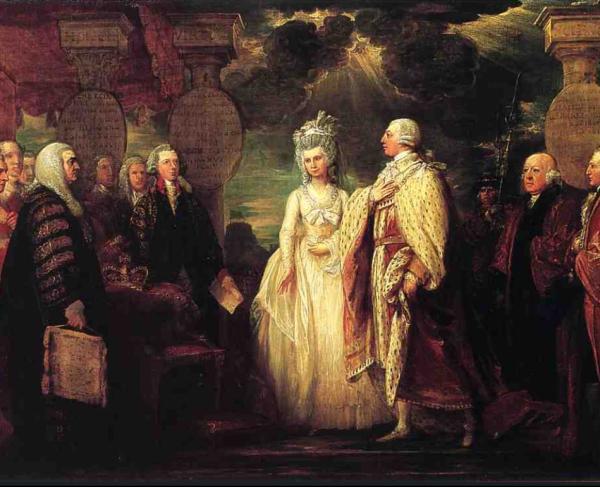
Petitioning the King and Parliament
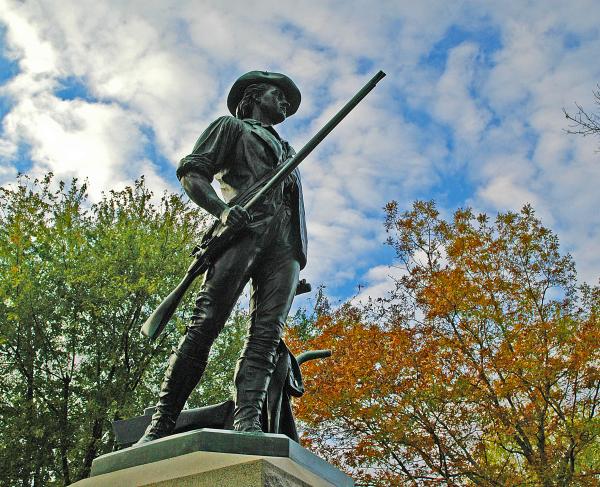
Minute Man National Historical Park
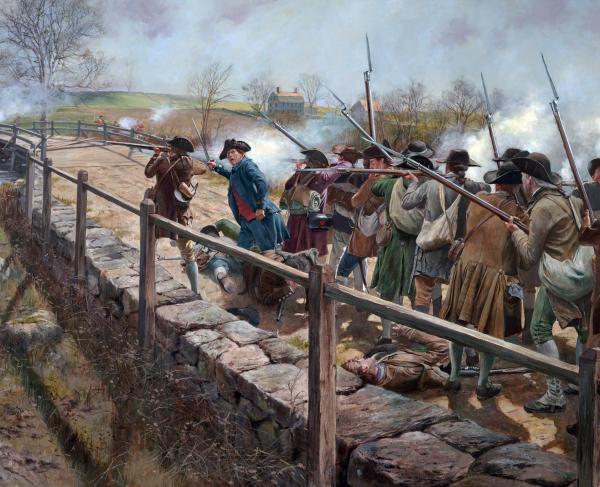
Old North Bridge
Related battles, you may also like.
What are the movements of the troops for both sides in the battle of Lexington and Concord?
The movements of troops for both sides in the battle of Lexington and Concord focus on capturing rebel leaders in Lexington as well as to destroy the Americans store of weapons and ammunition in Concord.
The Battles of Lexington and Concord (April 19, 1775) were the first skirmishes between British regulars and American provincials, kicking off the American Revolution . General Thomas Gage, newly appointed royal governor of Massachusetts, ordered his troops to seize the colonists' military stores at Concord in response to orders from London to suppress the rebellious colonists.
The British force of 700 men was met on Lexington en route from Boston by 77 local Minutemen and others who had been forewarned of the raid by the colonists' efficient lines of communication, including Paul Revere's ride. Who fired the first shot is unknown. At Lexington , the resistance disintegrated, and the British moved on to Concord.
Read more about Battles of Lexington
brainly.com/question/1600992
Related Questions
Select two main causes of the United States's war with Mexico: a) The United States and Mexico disagreed over the location of each country's borders. b) Mexico preferred to sell the land to France. c) Many Americans felt that it was the United States's destinty to expand throughout the North American continent. d) Britain offered to form an alliance with Mexico.
Explanation:
Many Americans felt that it was the United States's destinty to expand throughout the North American continent.
ally Or Examine the Marxian theory of the origin of State.
The Marxian theory of the origin of the state is based on the idea that the state arises as a result of class conflict and serves to maintain the power and privileges of the ruling class. According to Karl Marx, the state is not a neutral entity that exists to serve the common good, but rather a tool used by the ruling class to oppress and exploit the working class.
Marx believed that the state originated in ancient societies as a way for the ruling class to maintain their power and control over the means of production. As societies became more complex and the division of labor increased, the state became more centralized and powerful, with a professional bureaucracy and standing army to enforce the rules and maintain order.
In capitalist societies, Marx argued that the state serves to protect the interests of the bourgeoisie (the capitalist class) and maintain their control over the means of production. The state enacts laws and regulations that benefit the bourgeoisie and maintain the capitalist economic system, while simultaneously suppressing the working class and maintaining social and economic inequality.
According to Marx, the state will eventually wither away under communism, as there will be no need for a centralized authority to maintain class distinctions and the means of production will be owned and controlled by the entire society.
Why it is important to study gender and media together ?
Media play important roles in society. They report on current events, provide frameworks for interpretation, mobilise citizens with regard to various issues, reproduce predominant culture and society, and entertain (Llanos and Nina, 2011). As such, the media can be an important actor in the promotion of gender equality, both within the working environment (in terms of employment and promotion of female staff at all levels) and in the representation of women and men (in terms of fair gender portrayal and the use of neutral and non-gender specific language
Studying gender and media together is important because media has a powerful influence on how we view and understand gender roles and identities. It shapes our beliefs and attitudes towards gender and can perpetuate harmful stereotypes and biases. By studying gender and media together, we can better understand and critique the ways in which media represents and portrays gender, and work towards creating more inclusive and accurate representations. This is especially important in today's society where media is such a dominant force in our daily lives. By examining the intersection of gender and media, we can work towards creating a more equal and just society for all.
How a symbolic interactionist might answer the question "What is labeling theory"?
According to the labeling hypothesis , the terminology used to define or categorize people may determine or have an impact on their behavior and sense of self. It relates to the ideas of stereotypes and self-fulfilling prophecy.
Labeling theory is a crucial component of the symbolic interactionist view of deviance. Labeling theory, which was first put forth by sociologist Howard Becker in the 1960s, holds that deviation is that which is so branded. Before someone else evaluates it and assigns it a deviant label, no position or conduct is fundamentally abnormal.
Since classifying someone as illegally deviant might lead to criminal behavior, this notion is most frequently connected to the sociology of crime.
Learn more about labeling theory at:
https://brainly.com/question/13809461
name social and religous reformers inspired by swadeshi movement
Socio-Religious Reform Movements and Reformers in India: A Complete Overview
Raja Rammohan Roy (1772-1833)
Ishwar Chandra Vidyasagar.
Swami Vivekananda.
HP Blavatsky.
Annie Besant.
Henry Louis Vivian Derozio (1809-1831)
Sir Syed Ahmed Khan (1817-1898)
when taking notes for a discussion-based class, it is recommended that you organize your notes based on the list of issues or topics to be discussed.
When taking notes for a discussion-based class, it is recommended that you organize your notes based on the list of issues or topics to be discussed. The statement is true .
Discussion is described as speaking or writing about something, particularly to address a challenge or answer a query.
One of the most well-known and widely used note-taking strategies is the Cornell method , which was developed by Prof. Walter Pauk of Cornell University in the 1950s. Instead of just mentally noting things down, it forces you to actively consider your notes as you go.
Finding and writing down the most crucial ideas, concepts, and facts from the lecture in relation to the entire course is the key to taking notes that will both help with learning and be helpful for review.
Therefore, The statement is true .
Learn more about Discussion , here;
https://brainly.com/question/18599469
Please select the word from the list that best fits the definition States in which political power is exercised by and for the privileged few.
The word that best fits the definition 'States in which political power is exercised by and for the privileged few'. is the power-elite model.
Power-elite model refers to a system of governments where a small group of people has an unreasonable amount of power. They are known as decision-makers.
Such a system was operative in a dominant country like the US, the people having the powers are known as the elite. Elites exercise their powers in the economy, government, and military.
In the Power elite model power and wealth are concentrated in the hands of powerful rich people. This system is also referred to as the Oligarchy.
Thus power- elite model defines the definition of States in which political power is exercised by and for the privileged few.
To learn more about the power-elite model, refer,
https://brainly.com/question/11844800
The complete question is
Please select the word from the list that best fits the definition
States in which political power is exercised by and for the privileged few.
Power-elite model (last one)
EDGE 2023-2024
Use the map ( look at picture for map) to answer the following question. How did improvements in the transport affect the settlement patterns in the United State’s? A) improvements in the transportation did not have a significant impact on the migration pattern in the United States B) innovations to transportation made it less difficult for people to travel. west as a result the population in the West increased C) innovations to transport made it more difficult to travel west as a result the population was decreased D) innovations to transport it made it more difficult to travel to the East Coast as a result western population moved to East
Note that improvements in transport affected the settlement patterns in the United States in that: " innovations to transportation made it less difficult for people to travel. west as a result the population in the West increased (Option B)
People utilized donkeys, oxen, camels, and horse carts to carry people and goods in the past. People nowadays employ several advanced transportation methods such as railways, airplanes , and ships on water, among others. The traditional mode of transportation is extremely sluggish and time - consuming .
People developed more complicated modes of transportation over time. They discovered how to use wind, steam, and combustion , as well as electricity , to propel barges, ships, trains, vehicles, and airplanes.
Learn more about Transportation: https://brainly.com/question/28951650 #SPJ1
use text evidence to identify the sequence of events that led to showing the mian problem in desert holiday Ca use text evidence to identify the sequence of events that led to showing the mian problem in desert holiday Camera search mera search
In desert holiday , the tourist kept moving around the desert with no direction because they lost their way and couldn't capture the adventures with the camera they had
Text Evidence:
The group of tourists had spent the last few days traversing the desert in their camels, but now they were lost. They had been searching for a way out of the desert for hours, but had no luck. No matter how far they looked, there was no sign of civilization.
"It all started when the family went on a desert holiday . They had packed their camera and were looking forward to taking lots of great photos."
"But the camera suddenly stopped working, and the family could not take any pictures."
"They tried to fix the camera , but nothing seemed to work."
"After a few days of trying to get it to work, they realized that the camera had been damaged and was beyond repair."
"The family was disappointed that they could not take any photos of their holiday and the main problem of their desert holiday was revealed."
Sequence of Events:
1. Group of tourists spent days traversing the desert on camels
2. They became lost
3. They searched for a way out of the desert for hours
4. They looked far and wide but could not find any sign of civilization
5. Main problem was identified: they were lost and could not find a way out of the desert.
Learn more on desert holiday here;
https://brainly.com/question/21348408
Viewing the events of last January 6 needs to be placed in the context of a broader global crisis of “liberal democracy”. According to the 2021 World Freedom Report published by the think tank Freedom House, democracy has been in decline for 15 consecutive years, with some of the biggest setbacks occurring in the United States and India.
The events of January 6, 2021, were a deeply concerning attack on the U.S. Capitol, which is the seat of the U.S. government and a symbol of American democracy. The attack, which was carried out by a mob of supporters of then-President Donald Trump, resulted in the deaths of five people and was a serious breach of the peace. The attack was a shocking and unprecedented event, and it is important to understand the broader context in which it occurred.
You are correct that democracy has been in decline globally for some time. According to the 2021 World Freedom Report published by Freedom House, democracy has been in decline for 15 consecutive years, with some of the biggest setbacks occurring in the United States and India. This decline in democracy has been driven by a variety of factors, including the rise of authoritarian regimes, attacks on the media and civil society, and the erosion of democratic norms and institutions. It is important for people around the world to be aware of these trends and to work to defend and strengthen democracy wherever it is under threat.
Mormons moved from New York to the West in the early 1830s in order to a) obey the Book of Mormon. b) prosper in the fur trade. c) to avoid further religious persecution d) form an independent state
The answer is C) To avoid further religious persecution.
Hope this helped! Have a VERY GOOD day! : )
If accident is one type of disease, then safety is vaccine." Present your views on this subject with example
It's true that accidents can be considered a type of disease in the sense that they are unexpected events that can cause harm or injury. In this sense, safety can be seen as a way to prevent accidents and protect against their negative consequences, much like a vaccine protects against illness.
For example, wearing a seatbelt while driving is a safety measure that can help prevent serious injury or death in the event of a car accident. Similarly, wearing a helmet while riding a bike or practicing safe sex can help prevent head injuries and sexually transmitted infections, respectively.
Overall, the idea of using safety measures as a way to prevent accidents and protect against their negative consequences is a useful way to think about how to stay healthy and avoid harm in our daily lives.
I think this statement is expressing the idea that being safe and taking precautions can help prevent accidents, which can be thought of as a type of disease in the sense that they can cause harm or suffering. For example, if someone is driving a car and they follow all the rules of the road and take precautions such as wearing a seatbelt and not texting while driving, they are less likely to be involved in a car accident. In this sense, practicing safety could be seen as a "vaccine" against the "disease" of accidents.
This idea can be applied to many other areas as well. For example, if someone is working with hazardous chemicals in a laboratory, following proper safety procedures and wearing protective gear can help prevent accidents or injuries. Similarly, if someone is participating in a sport, wearing the appropriate safety equipment (such as a helmet or padding) can help reduce the risk of accidents and injuries.
Overall, the concept of safety is an important one, as it can help prevent accidents and reduce the risk of harm or injury to individuals.
the task-oriented leader, according to fiedler, excels in the favorable situation, whereas relationship-oriented leaders are most effective in situations of moderate favorability.
The task-oriented leader , according to fiedler, excels in the favorable situation, whereas relationship- oriented leaders are most effective in situations of moderate favorability. The statement is true.
A relationship is how two or more people interact with one another or how they are related to one another.
In situations with moderate favorability , Fiedler claims that people who value relationships make the best leaders. A task-oriented person will be the greatest leader for the job in either a very favorable or not at all favorable condition. Instead of looking for new leaders to fit the circumstance, contemporary organizations frequently employ the Fiedler contingency model to assist them modify the situation to fit a leader. This strategy can also be used to assign different management personnel to the activities or projects that best suit their skills .
Learn more about Relationship , here;
https://brainly.com/question/23752761
Which of the following was necessary to fulfill the idea of Manifest Destiny? a) nullification of unjust tariffs b) the support of the Supreme Courts c) expansion of suffrage d) advances in transportation
Individuals, businesses, and governments make economic decisions by considering two important factors. Identify and define these two factors, and give an example of each. (1.4.3 Test: Fundamental Principles of Economics, Apex).
Most time, Individuals, businesses, and governments make economic decisions by considering two important factors which are:
The external choices is influenced by external factors such as political, economic, sociocultural, technological, environmental, and legal factors while the internal choices is influenced internal factors such as things like values, management styles, Human Resources, technological and physical resources, and organizational structure.
Read more about economic decisions
brainly.com/question/27906700
erception that is guided by higher-level knowledge, experience, expectations, and motivations is known as multiple choice
The erception that is guided by higher-level knowledge, experience, expectations, and motivations is known as Top-down processing . Thus, option A is correct.
Top-down processing refers to how we perceive the world around us by drawing on what we already know to interpret new information.
Top-down theories are hypothesis - driven and emphasize the significance of higher mental processes like expectations, beliefs, values, and social influences.
Therefore, Top-down processing refers to perception that is guided by higher-level knowledge, experience, expectations , and motivations .
Therefore, option A is correct.
To learn more about the Top-down processing , refer to:
https://brainly.com/question/5641438
The question seems incomplete, most probably, the question was:
The multiple choices are:
omar is asked to report what he sees in an ambiguous picture and is asked to provide story about what is happening in the picture. omar is most likely being given the:
Omar is most likely assigned the task of providing a description of the photograph as well as a narrative or story about it.
To generate doubt , visual shapes known as ambiguous images or reversal figures employ graphical similarities and various other features of how the visual system interprets two or more separate image patterns.
This can include finding particular objects and people in the photograph, assuming their actions and intentions, and assessing the scene and any other relevant information. In order to develop a credible and cohesive narrative , Omar may need to engage his critical processing abilities and base his educated guesses on the indications in the image.
Learn more about ambiguous picture here:
brainly.com/question/29892025
Why six intimacies are considered as critical to a healthy intimate relationship according to Frank Reed?
1. Physical Intimacy
2. Emotional Intimacy
3. Intellectual Intimacy
4. Creative Intimacy
5. Experiential Intimacy
6. Spiritual Intimacy
Hope this helped you! If brainliest would u give me!
Which of these events would be a result of inflation? A business reports a loss for a tax year. A CEO pays less in taxes than five years ago. A company scales back production. An economist advises expansionary policy.
None of the events listed would necessarily be a result of inflation. Here is a brief explanation of each event:
Inflation is the sustained increase in the general price level of goods and services in an economy over a period of time . It is usually measured by the consumer price index (CPI). Some common effects of inflation include a decrease in the purchasing power of money, an increase in the cost of living, and a decrease in the real value of financial assets.
according to world system theory less developed Nations will eventually resemble the more developed nations in terms of economic and social structure. T or F
The given statement is false.
The world systems theory was propounded by Immanuel Wallerstein. It is an approach to understanding world history and social change.
In this theory, Wallerstein argues that there is a world economic system in which some countries benefit while others are exploited.
The main points of this theory are:
It establishes a three-level hierarchy of core, periphery, and semi-periphery areas. In which-
This theory emphasizes the global inequality present in the World.
Wallerstein argues in his thesis that, less developed nations will never come at a degree of resemblance with the core countries as core countries will never stop exploiting the less developed countries.
To know more about world system theory-
https://brainly.com/question/13931326
6. - 8. Part II Choose Correct answer for the following questions Which of the following one is true about Anthropology? A) ItProduces knowledge about the actual biological and cultural variations in the worldB)It offers methods and theoretical perspectivesC) It enables the practitioner to explore, compare, understand and solve these varied expressions of the human condition D) All are correct answer 7. From the following aspects one is Socio-cultural anthropologists engaged to study? A)Ethnography B) Ethnology C) Biology D)A&B is correct Which one of the following one is Not Sub-fields of Anthropology? A. Physical Anthropology B. Psychology C. Linguistic Anthropology D. Socio-Cultural Anthropology. EArchaeology which of the following one is /are the focuses of socio cultural anthropology? A) It deals with human society and culture B.) It studies human language as a cultural resource C) It studies the ways of lives of past peoples by using material remains D.) None
To answer the questions about Anthropology:
6. D. All are the correct answers about Anthropology .
7. Socio-cultural anthropologists engaged to study D. A and B are correct.
8. B. Psychology is not a Sub-field of Anthropology.
9. The focus of socio-cultural anthropology is A. It deals with human society and culture
Anthropology is the study that focuses on the origin and development of human societies and cultures.
Anthropologists investigate the features of past and present human communities using a variety of techniques.
Socio-cultural anthropology , linguistic anthropology, biological or physical anthropology, and archaeology are the fields of Anthropology.
Thus, in conclusion, Anthropology is concerned with the actual biological and cultural differences in the world.
Learn more about Anthropology at brainly.com/question/13728734.
The events of January 6, 2021, when a mob of supporters of former President Donald Trump stormed the U.S. Capitol in an attempt to disrupt the certification of the presidential election, were a disturbing and disturbing manifestation of the broader crisis of liberal democracy that is currently affecting many countries around the world.
As the 2021 World Freedom Report published by the think tank Freedom House notes, democracy has been in decline for 15 consecutive years, with some of the biggest setbacks occurring in the United States and India. This trend is alarming, as it suggests that more and more countries are experiencing challenges to the fundamental principles of liberal democracy, such as the rule of law, free and fair elections, and the protection of human rights.
The events of January 6, 2021, can be seen as part of this broader trend of democratic decline. The mob that stormed the U.S. Capitol was motivated by a belief that the presidential election had been stolen, and their actions represented an attempt to subvert the democratic process and undermine the rule of law. The violence and chaos that ensued were a clear threat to the stability and integrity of the U.S. democratic system.
Overall, it is important to view the events of January 6, 2021, in the context of the broader global crisis of liberal democracy. This crisis is a serious threat to the stability and prosperity of many countries around the world, and it is essential that steps be taken to address and reverse this trend.
neuroimaging experiments have demonstrated that working memory engages the
Neuroimaging experiments have demonstrated that working memory engages the prefrontal cortex and more posterior brain areas involved in perception and mental representation
Neuroimaging experiments are research studies that use techniques such as magnetic resonance imaging (MRI), positron emission tomography (PET), and functional MRI (fMRI) to visualize and analyze brain activity.
These techniques allow researchers to study the structure and function of the brain, and to explore how the brain is involved in various mental processes and behaviors.
Therefore, Neuroimaging experiments can be used to study a wide range of topics, including brain development , learning and memory, language and communication, and the effects of diseases and injuries on the brain.
Learn more about brain from
https://brainly.com/question/17018018 #SPJ1
“What do we mean by the Revolution? The war? That was not part of the revolution; it was only an effect and consequence of it. The revolution was in the minds of the people, and this was effected from 1760-1775, in the course of fifteen years, before a drop of blood was shed at Lexington.” - John Adams, 1815 Based on this quotation about the American Revolution, Adams was probably
Note that based on the above quotation, Adams was probably, "connecting the revolution to people’s individual rights and freedoms." (Option D)
John Adams was an American statesman, lawyer, diplomat, writer, and Founding Father who served as the country's second president from 1797 to 1801. He signed the contentious Alien and Sedition Acts and strengthened the Army and Navy in the undeclared naval conflict (dubbed the "Quasi-War") with France.
During his presidency, he was the first president to live in the executive residence that is now known as the White House.
According to John Adams, the American Revolution marked a significant shift in how people saw their rights and liberties. He claims that this shift happened in people's thoughts over a 15-year period and that the conflict was only a manifestation of this deeper shift.
He in the above text is distinguishing the conflict from the larger social and political developments that preceded it, emphasizing the significance of individual rights and liberties as a driving factor behind the revolution.
Learn more about John Adams : https://brainly.com/question/12416301 #SPJ1
Full Question:
“What do we mean by the Revolution? The war? That was not part of the revolution; it was only an effect and consequence of it. The revolution was in the minds of the people, and this was effected from 1760-1775, in the course of fifteen years, before a drop of blood was shed at Lexington.”
- John Adams, 1815
Based on this quotation about the American Revolution, Adams was probably
A) demonstrating that every cause has an effect.
B) establishing a timeline that led up to the war.
C) separating the war from the abuses that precipitated it.
D) connecting the revolution to people’s individual rights and freedoms.
Why did tensions exist between Native American groups and white settlers? (2 answers) A) Native Americans received access to better land than white settlers when they were removed to the west. B) Native Americans like the Seminole resisted white settlement by attacking U.S. army. C) White settlers offered to protect Native Americans west of the Proclamation Line of 1763. D) Settlers with a larger population and more weapons attacked Native Americans to force them to give up land.
Answer: D and B
Tensions between Native American groups and white settlers arose for a variety of reasons, including conflicts over land, resources, and cultural differences. One of the main causes of tension was the expansion of white settlements into areas that were traditionally inhabited by Native American tribes. As settlers moved westward in search of land and resources, they often encountered resistance from Native American groups who saw the settlers as a threat to their way of life.
In some cases, white settlers used their superior numbers and weapons to force Native Americans off of their land, either through violence or through government policies such as treaties and removal orders. This led to a long history of conflict between Native American groups and white settlers, as Native Americans sought to defend their land and their way of life.
In addition to these issues, tensions also arose as a result of cultural differences and misunderstandings between Native American groups and white settlers. Many Native American cultures had different ways of life and different values than those of the settlers, which could lead to misunderstandings and conflicts.
Option A) is incorrect, as Native Americans were not given access to better land than white settlers when they were removed to the west. In fact, Native Americans were often forced to leave their ancestral lands and move to areas that were less desirable or less suitable for their way of life.
Option C) is also incorrect, as white settlers did not offer to protect Native Americans west of the Proclamation Line of 1763. The Proclamation Line was a boundary established by the British government that prohibited white settlement west of the Appalachian Mountains. It was intended to reduce conflict between Native Americans and settlers, but it was not successful in preventing tensions and conflicts from arising.
1. Assume that worker productivity in Country X increases due to improved training. At the same time, there is a decrease in the labor force due to people moving out of Country X. What happens to the country's market equilibrium quantity of labor and wage rate? a. The quantity of labor increases, and the wage rate increases. b. The quantity of labor decreases, and the wage rate increases. c. The quantity of labor and the wage rate both remain constant. d. The effect on the quantity of labor is indeterminate, and the wage rate increases. e. The quantity of labor increases, and the effect on the wage rate is indeterminate. 2. The number of units of output that a machine will produce increases, ceteris paribus. How will this change in productivity affect demand for the machine? a. Demand for the machine will increase. b. Demand for the machine will decrease. c. There will be no change in demand for the machine. d. Demand will not change, but quantity demanded will decrease. e. Demand will not change, but quantity demanded will increase. 3. Based on the graph, which of the following factors can cause the market labor supply curve for the telecommunications industry to shift from S1 to S2? (The supply curve is shifting left) a. A decrease in the number of workers qualified to work in telecommunications b. A shift in cultural values toward work within telecommunications c. A decrease in the number of domestic residents emigrating to foreign countries d. A decrease in the wage rate of all telecommunications workers within the country e. A decrease in the value of leisure time by all domestic telecommunications workers 4. If the price of a factor of production decreases, ceteris paribus, the suppliers of that factor will respond by a. changing the quality b. increasing the quantity available c. increasing the productivity d. decreasing the productivity e. decreasing the quantity available
1. From the scenario given, What will happen to the country's market equilibrium quantity of labor and wage rate is that the quantity of labor decreases, and the wage rate increases. (Option B).
2. The change in productivity will affect demand for the machine in that demand for the machine will increase. (Option A).
3. The factor that cause a shift is a decrease in the wage rate of all telecommunications workers within the country. (Option D).
4. If the price of a factor of production decreases, ceteris paribus, the suppliers of that factor will respond by Increasing the quantity available. (Option B).
Wage rate refers to the amount of money that an employee is paid per hour of work. It is a key factor in determining the cost of labor for a company or organization and is used to set the price of products or services.
Finally, wage rates can vary widely depending on the industry , the type of work being performed, the location, and the worker's level of education and experience. They are typically negotiated between an employer and an employee or an employee's union representative.
Learn more about wage rate here: https://brainly.com/question/17236532
Do you believe that as nature has an impact on the individuals' mo Please briefly discuss on the issue?
It is generally accepted that an individual's environment, including the natural environment, can have an impact on their development and behavior. The natural environment, including factors such as climate, topography, and the availability of resources, can shape the way that individuals live their lives and interact with the world around them.
For example, living in a region with a harsh climate may require individuals to adapt and develop certain skills or behaviors in order to survive and thrive. Similarly, living in an area with abundant natural resources may allow for a different way of life and a different set of opportunities.
There is also evidence to suggest that exposure to nature and natural environments can have positive effects on an individual's physical and mental health. Studies have shown that spending time in natural environments can improve stress levels, reduce anxiety and depression, and increase overall well-being.
Overall, it seems clear that nature has an impact on individuals, and that the natural environment can play a significant role in shaping an individual's development and behavior.
Health and social care level 2 (adults) List what personal attributes and behaviours are expected of an adult care worker?
The personal attribute is support individuals they are working with according to their personal care or support plan.
A specification for a property of an object, element, or file in computing is known as an attribute . Furthermore, it can make a precise reference to or set a value for a particular instance of such. Attributes should actually be categorized as metadata for the sake of clarity . Usually, a property of a property is what is known as an attribute. Depending on the technology under consideration, the term attribute, however, can and is frequently interpreted as being similar to a property . An element's type or class name; a file's name; and an object's name and value often make up an attribute of that particular object. Line objects, for instance, can have characteristics like thickness, color, dashing qualities, etc. in computer graphics.
To learn more about attribute , visit:
https://brainly.com/question/14890225
if a person is treated nicely because she is a friendly person the mechanism of _____ may be operating.
If a person is treated nicely because she is a friendly person the mechanism of evocation may be operating.
The intriguing idea that many of the modal human tendencies are made by particular people' personality traits is suggested by the technique of evocation . The predominant social context that stimulates modal human tendencies may be made up of other people's personality traits.
The methods in which people unintentionally cause predictable responses from others in their social contexts are referred to as evocation. The techniques people purposefully employ to modify, exploit, or alter the social surroundings they live in are referred to as manipulation.
The methods in which people unintentionally cause predictable responses from others in their social contexts. The intriguing idea that many of the modal human tendencies are brought out by particular people' personality traits is suggested by the technique of evocation.
Evocation may be in action if someone is treated well because they are a kind person.
Find out more on evocation at https://brainly.com/question/9832207
Section 2 On each of the lines between the branches of government, write a different way in which that branch checks the powers of another branch. Note which way the arrows point. They indicate which branch is checking the other branch. One has been completed for you. Executive Branch May veto bills Judicial Branch CHARTER Legislative Branch
(executive -------> legislative) Executive Branch : May veto bills
(Judicial -------> legislative and executive) 'Judicial Branch: May declare laws or executive actions unconstitutional
( legislative ------>executive and judicial) Legislative Branch: May impeach and remove executive and judicial officials
Generally, The branches of government are the executive, legislative, and judicial branches.
The executive branch is responsible for administering and enforcing the laws of the country. It is headed by the president and includes other officials such as the vice president, cabinet members, and federal agencies.
The l egislative branch is responsible for making the laws. It is made up of Congress, which is divided into two chambers: the Senate and the House of Representatives. The judicial branch is responsible for interpreting the laws and constitution. It is made up of the Supreme Court and other federal courts.
All three branches are separate and independent, with each having its own powers and responsibilities.
Read more about branches of government
https://brainly.com/question/16327953
- Skip to global NPS navigation
- Skip to this park navigation
- Skip to the main content
- Skip to this park information section
- Skip to the footer section

Exiting nps.gov
Alerts in effect, april 19, 1775.
Last updated: September 29, 2022
Park footer
Contact info, mailing address:.
North Bridge / Park Headquarters 174 Liberty St. Concord, MA 01742
978 369-6993
Stay Connected
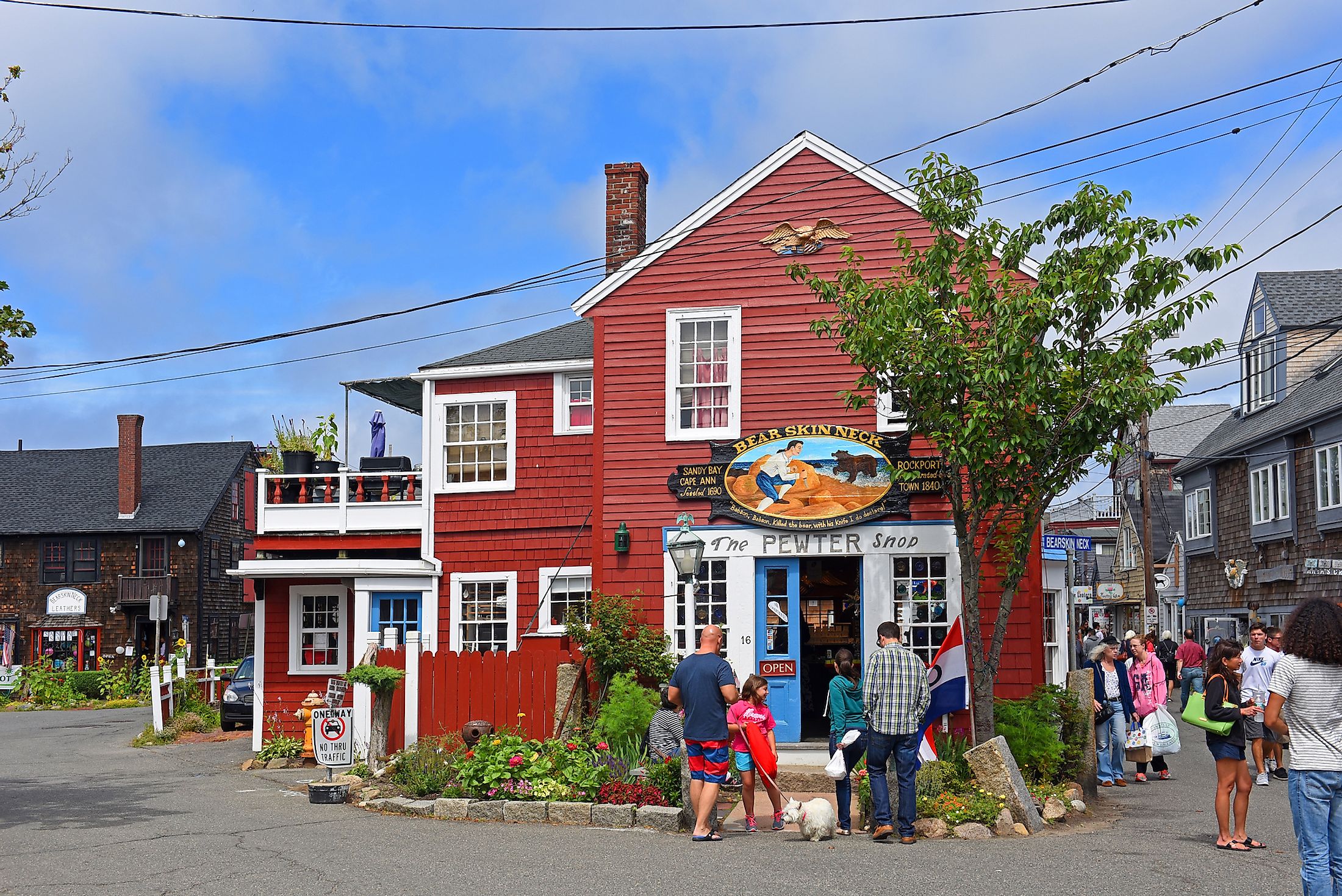
- 9 of the Most Walkable Towns in Massachusetts
Massachusetts is a state of first steps, as evidenced by the famed pilgrims who first touched ground at Plymouth Rock in 1620, ripe from a long Atlantic voyage on the Mayflower. These days, the state is much more traversable than the water-logged forests it once was, thanks to intentionally designed suburbs that wrap around opportunity-rich main streets. Yet, “walkable” is more than just efficient pedestrian routes to essential goods— it is a way of life that fosters community interaction. So, live your best life and stride through these gorgeous towns today.
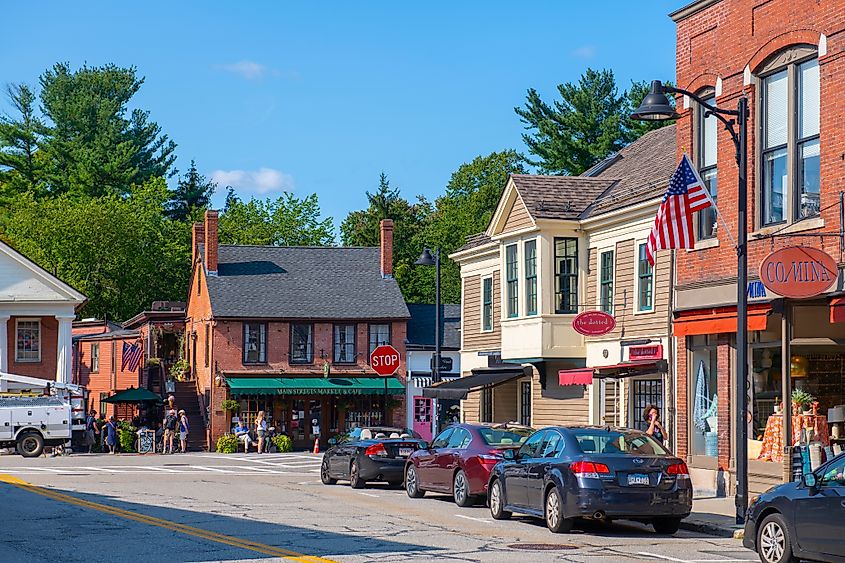
Twenty-five square miles is no mammoth space to patrol when it is evident that Concord is lined by forests and rivers between suburbs that dawdle and curl around its developed hubs. Even those living at the farthest corners could get by on foot (or bicycle if in a hurry) when it comes to accessing essential goods on the Main St connecting Concord and West Concord.
The colonial alley style matches the environment well around the Main Streets Market & Cafe, and these brick facades truly put the “ England ” back into “ New England .” Like most of the towns here, the cuisine, culture, and shopping options are easily praised, but the layout and aesthetic of Concord deserve kudos of their own.
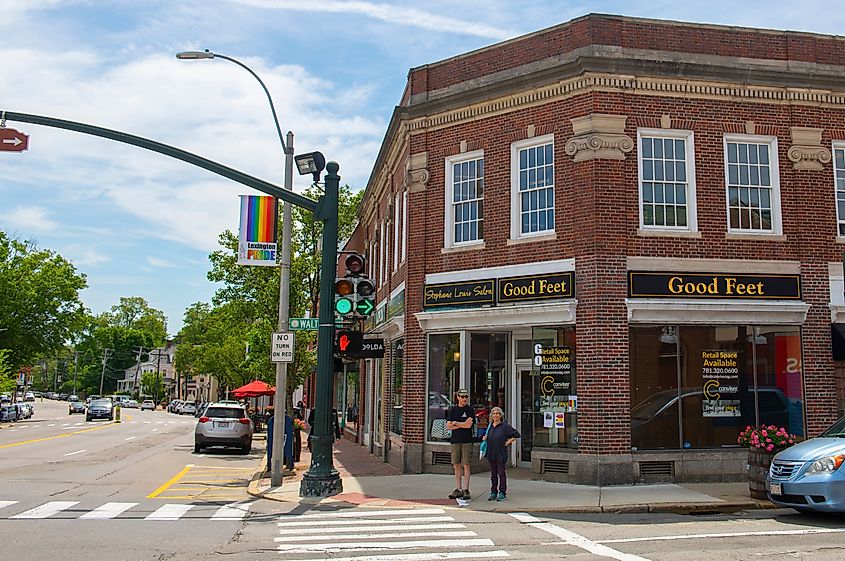
Lexington is a masterclass in suburban design: weaker neighborhoods feature grid patterns that are efficient yet brutalist, or spiderwebs that are chaotic and dangerous when vehicles are involved. Instead, Lexington opts for neighborhoods that conveniently converge on a central main street with libraries, a Thai Kitchen, a bistro, and other necessities like a children’s center and Family Dental.
Green spaces are king when it comes to defining “walkability,” so the Lexington Battle Green Park is the pulsing heart of the Lexington community, and golf courses, farms, and adorable trails are dispersed evenly between residential areas. The high school is also central, so no student is disadvantaged by a 5-mile walk compared to other peers who live closer, and sports fields and tennis courts are less than a block away. After all, walkability does not have to mean “pilgrimage.”
Northampton
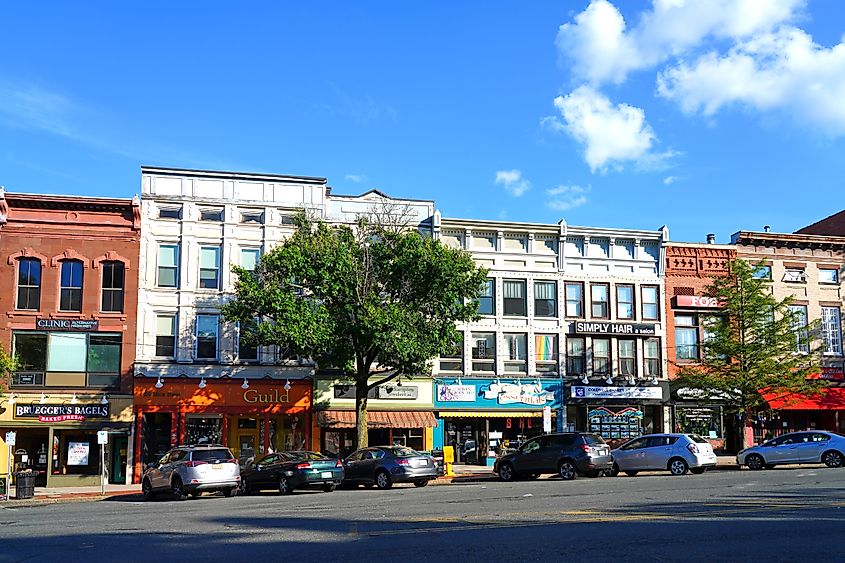
A quiet town of less than thirty thousand, something about Northampton just feels like home. Steeples and bakeries line its central thoroughfare, which is spacially the opposite of claustrophobic. For those lucky enough to occupy an apartment above a shop like Meriyem’s Cafe or Ted’s Boot Shop, every day must be like strolling into a small-town television show. And stroll these pedestrians do— the Three Country Horse Show and Fairgrounds are less than a fifteen-minute walk away, and the Smith College Japanese gardens are less than a mile away to the west.
For other folks, residences occupy the majority of space between those “downtown” shops and the Big Y World Class Market/Walmart/Big Lots department stores a mile and a half away. However, those looking for a moment of reprieve will revel in the Rainbow and Riverbank roads, which peacefully trail beside the magnificent Connecticut River ; one can even wave to folks doing the same on the opposite side during a clear day.
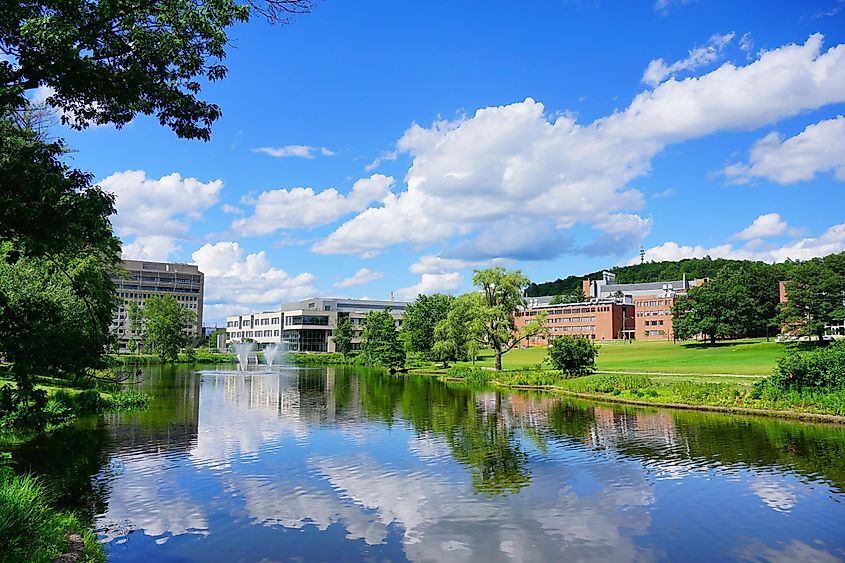
Many know this academic town for hosting one of the Little Ivies, “Amherst College,” and it goes without saying that university students with countless academic options ultimately are convinced by a quality town and environment.
Recreation and conservation areas, such as Mill River and Wildwood, are handsomely proud enclaves for poets and dreamers who have had the privilege of walking here for centuries. That said, the quiet cemeteries are a privilege to visit because they contain the names and stories of people who literally built the foundation of New England and, daresay, the United States , so they are wonderfully curated places for distant relatives and respectful visitors alike.
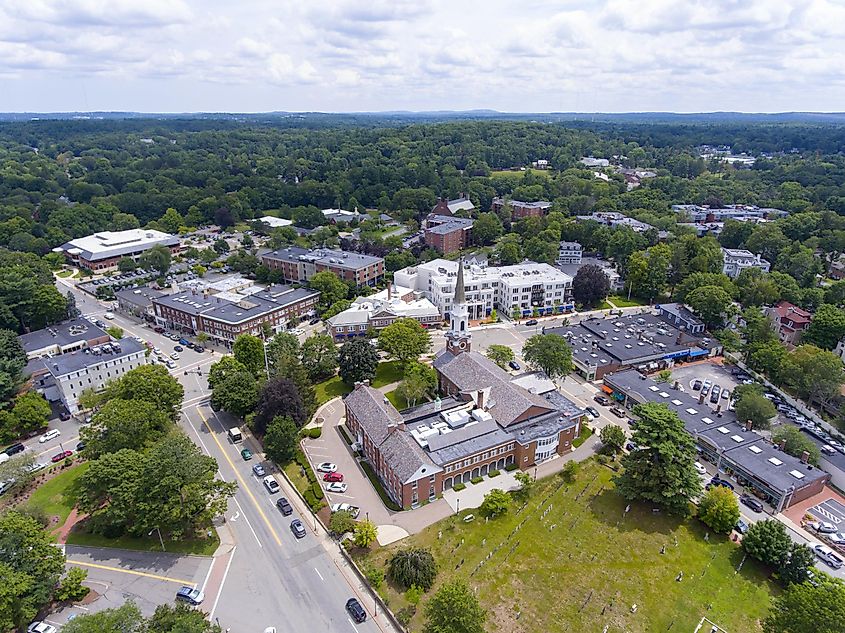
Wellesley offers Bostonians (the city conveniently sits less than 10 miles away) a rare opportunity to lounge in the sun at spots such as Morses Pond beach; a tan is a valuable sight in the northeast, after all. Lake Waban, with mother geese parading their trophy goslings close behind, is a quarter mile away from Morses Pond if a change of scenery is needed.
Another appeal for those who like to keep their commutes pleasant and close is that Roche Bros, the primary supermarket, is squarely in the middle of town, just behind Linden St, which hosts the majority of shops and bakeries. Quite a few K-12 schools and colleges are sprinkled throughout, so parents need not be concerned about young ones trotting a path with their friends rather than taking a bus.
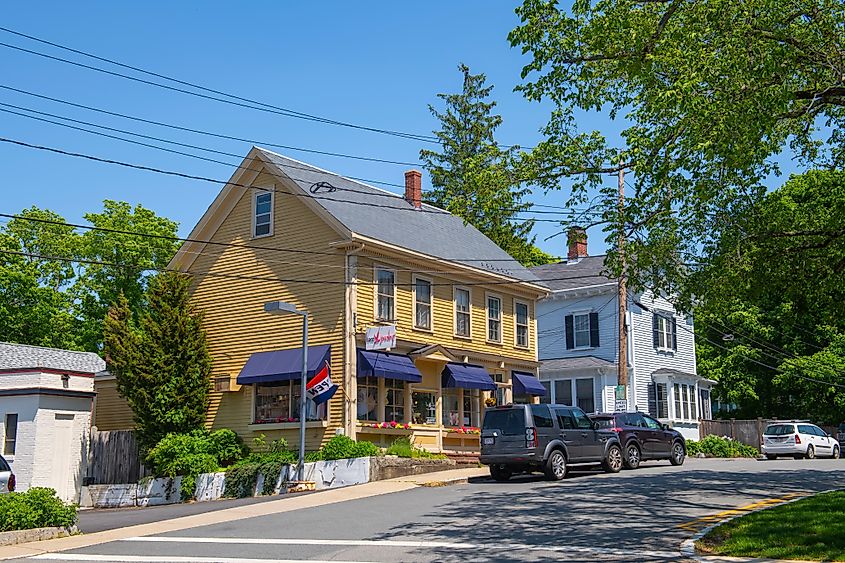
For a modest community of approximately 14-thousand, 10 square miles of water area is a remarkable amount, but seeing as Ipswich is on the coast, the math adds up. Speaking of which, the duly named Ipswich Bay hosts miles of idyllic sandy shoreline, which take the cake in afternoon strolls. Observation boardwalks with coin-operated binoculars afford curious gazers a chance to spot a roaming sailboat or a creature prowling the sandy grass dunes at Plum Island State Park.
Regarding the town, the majority of citizens occupy a central zone two miles inland up the Ipswich River. Hiking trails, bridges, and railroads crisscross the area, which means there is always a corner for the curious to sniff away at while stretching their legs with pets.
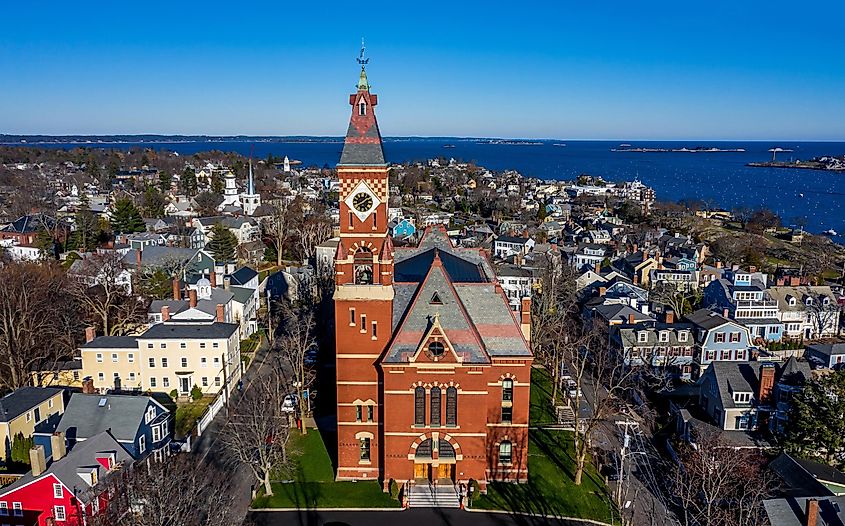
To the southwest, Marblehead occupies a peninsula that reaches out into the Atlantic. History is a specialty of this region, which lies adjacent to the infamous Salem and within walking distance of the Peabody Essex Museum. Its own historic district is crammed with fantastic architecture from eras long ago and the occasional beachfront or lighthouse.
A pedestrian-friendly bridge connects the mainland town with an island that hosts parks like Castle Rock and Chandler Hovey. This unique island safeguards a wildlife sanctuary at its heart that is praised by local guides for bird spotting, with species like the Yellow Crown Night Heron making nests throughout the trails.
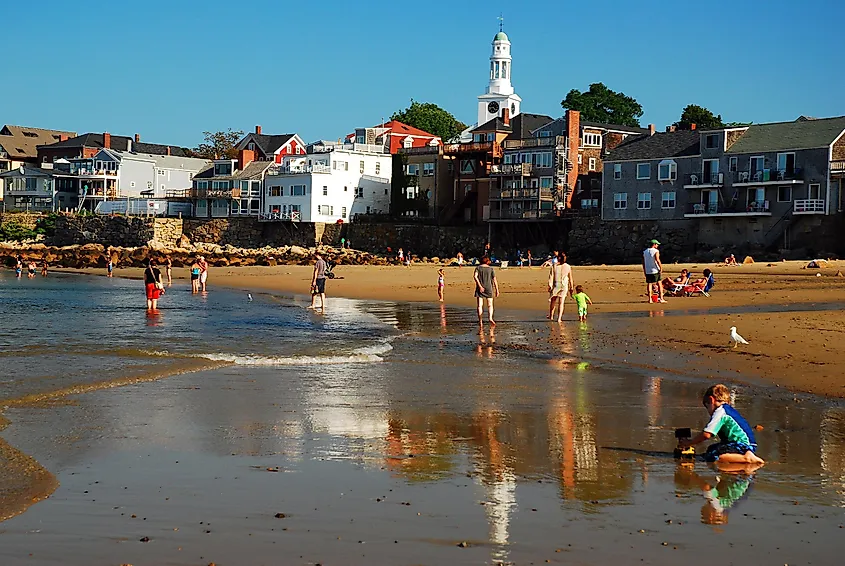
Over in Essex County, Rockport is a creative haven occupying coastal forests. Art shops and music centers take center stage on Main St, but iconic saltwater taffies from Tuck’s Candy & Gifts are nothing to pass-up, either.
Within just a few leaps and bounds, Front Beach and Back Beach Landing offer safe places to swim and relax in Back Harbor, and the perfect lunch can be cooked up at The Fish Shack Bar & Restaurant for an afternoon of delights, no car needed. For some last bonuses, Rockport also has a Community Cinema right by a train station that sits amongst hardwire, grocery, ice cream, and other useful venues.
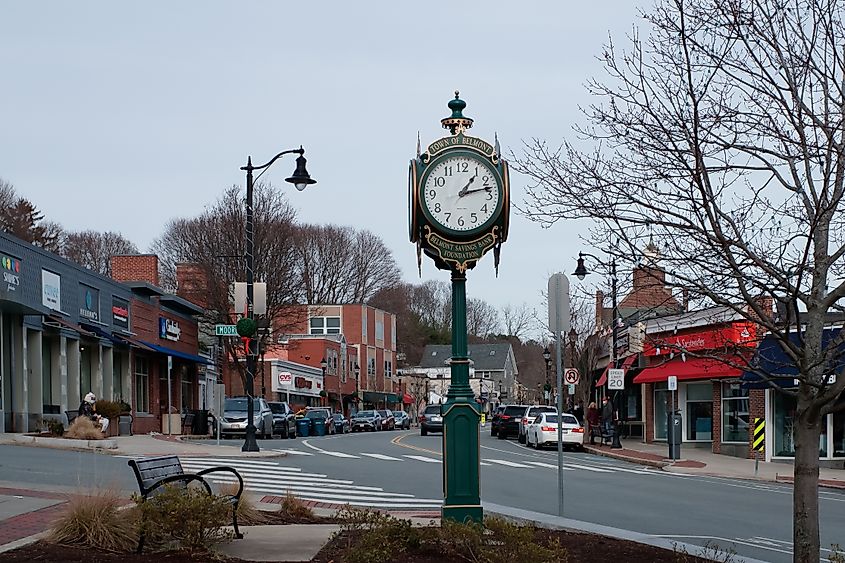
For the last stop on this tour, Belmont is a remarkable pick. Arguably, Belmont comprises the benefits from the majority of the other towns, such as a bustling central plaza with pizza shops and sporting goods, while also not neglecting mindful citizens by hosting a regular farmers market in a dedicated space right by the main thoroughfare, Leonard St.
Personality-wise, Belmont is a refuge for bookworms, artists, the pious, and those who need to disappear into the forest to bask in sun rays under a leafy green canopy now-and-then. Incredibly, amongst all the other attractions, Belmont residents managed to fit three luxurious golf courses in the corners of the town as well, and why drive a cart in a town so perfect for wandering on foot?
Final Thoughts
In contrast to the pedestrian-resistant “stroads” that make an afternoon walk both confusing and dangerous throughout America’s frontiers, Massachusetts has refined the fine art of a pleasant afternoon on foot. Historically, this reality makes sense as Boston itself is considered one of the most walkable cities in America, and the same talent that maintains this reality has ensured the same for elsewhere in the state, a fact highlighted by these remarkable towns. Grab a comfy outfit and some quality shoes because it is time to meet the neighborhood.
More in Places
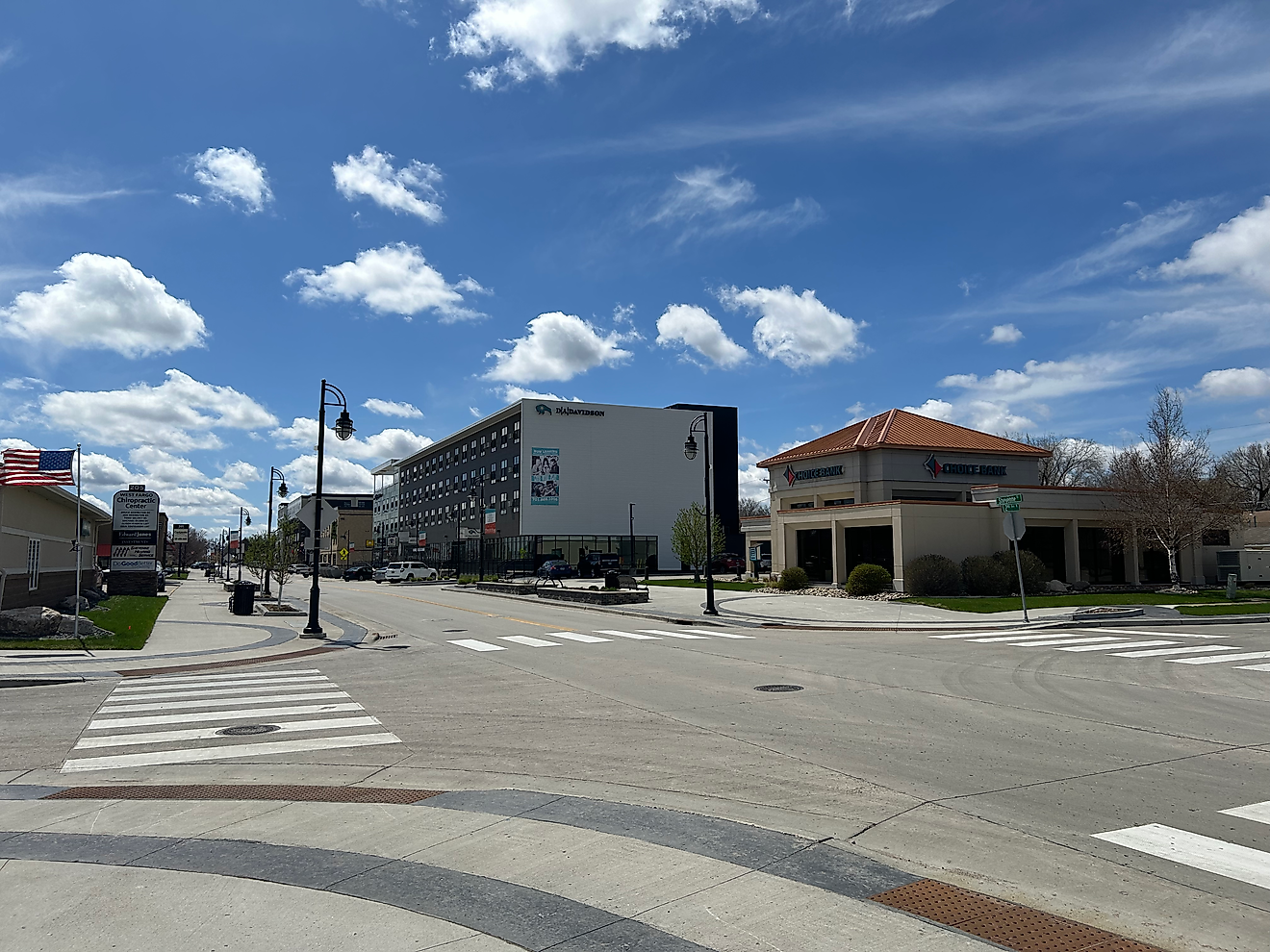
7 Towns in North Dakota With Thriving Local Businesses
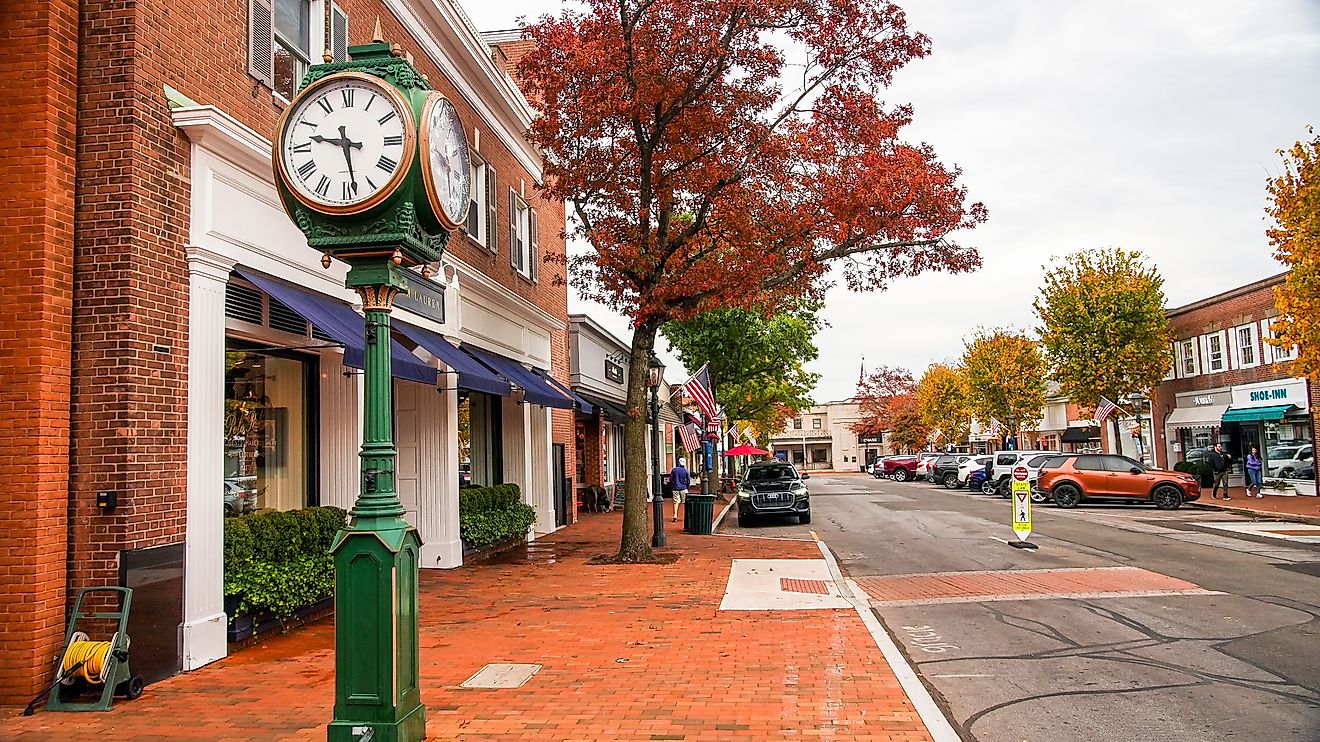
7 Most Beautiful Small Towns In Connecticut to Visit in 2024
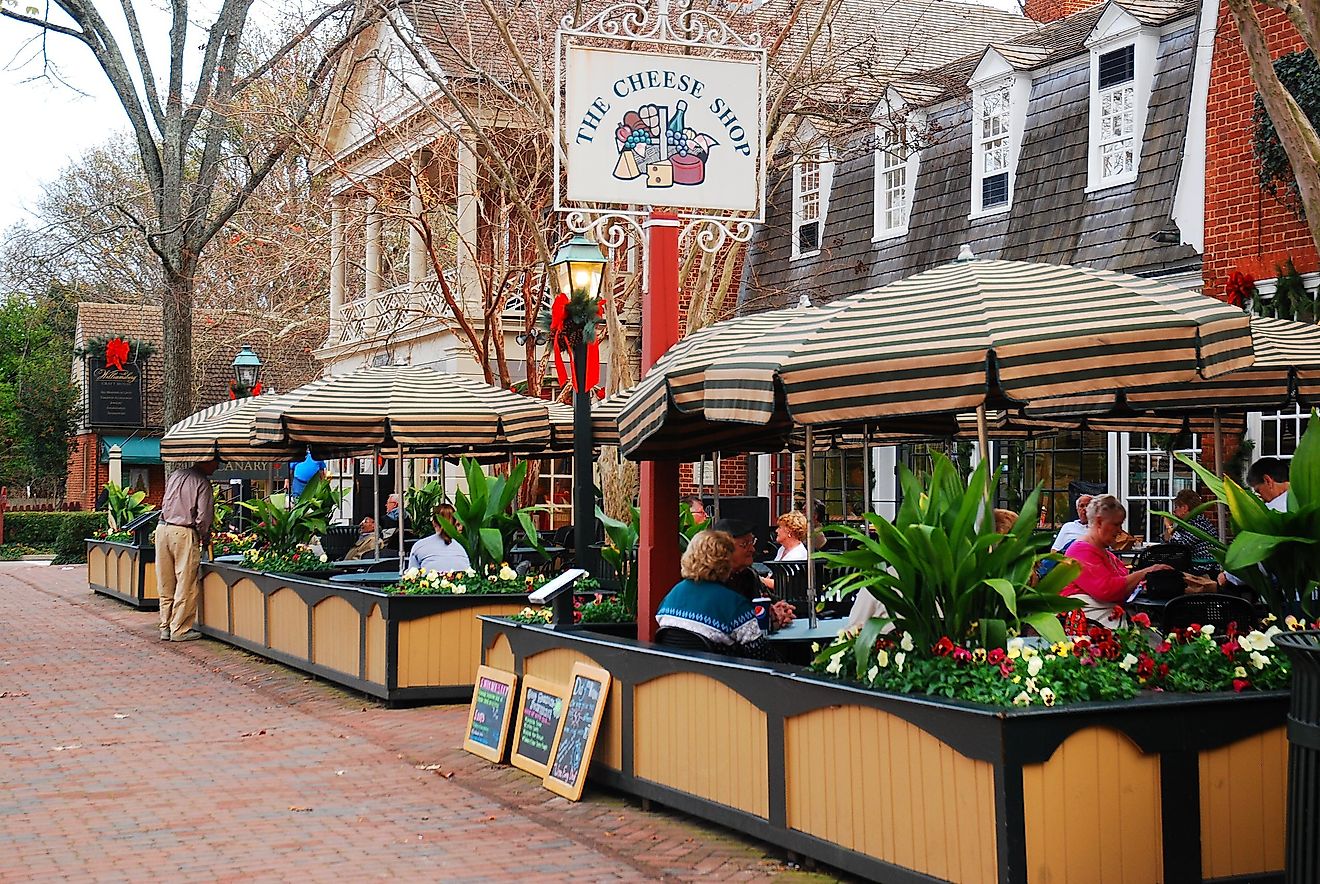
11 Adorable Small Towns in Virginia to Visit in 2024
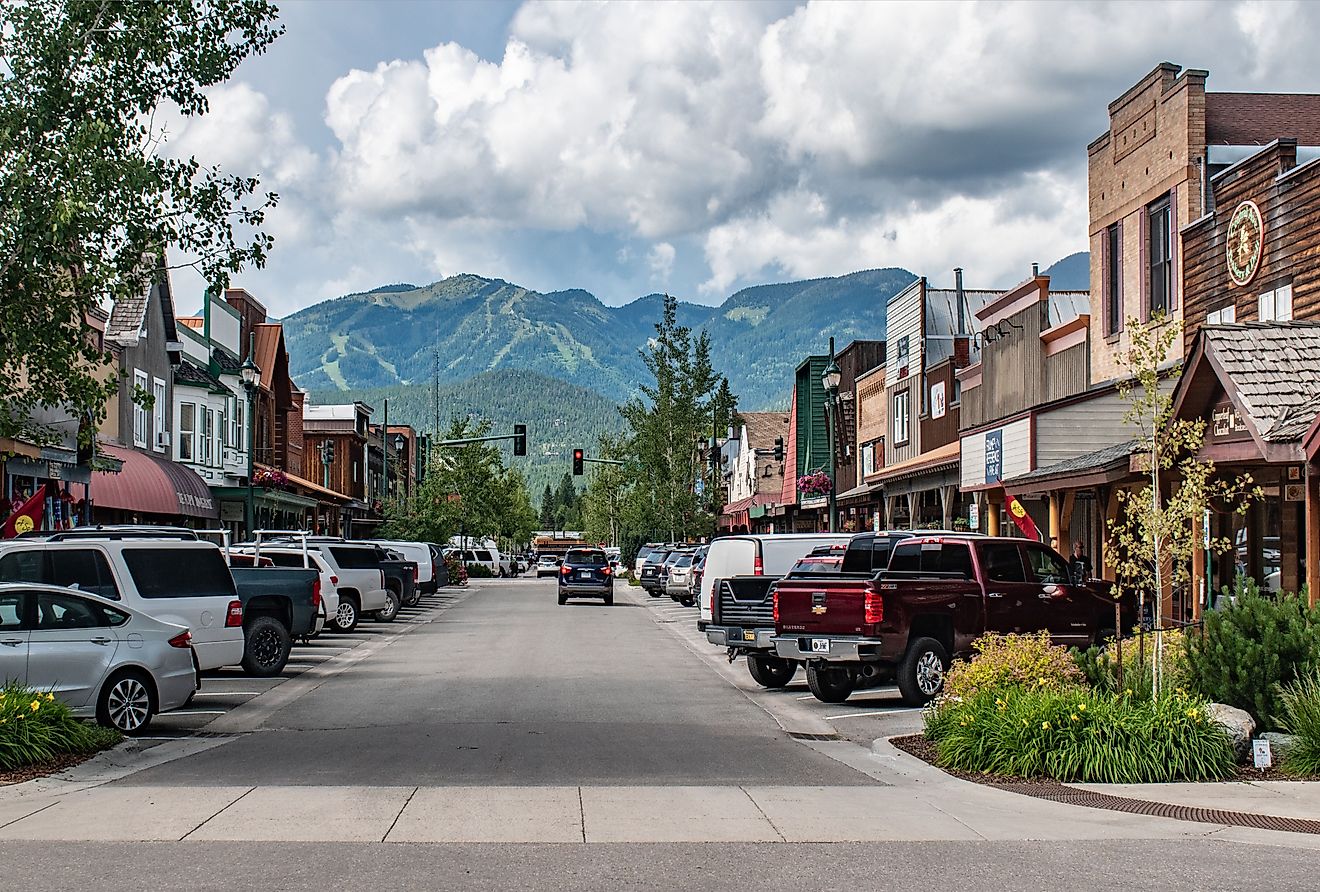
9 Must-Visit Small Towns in Montana
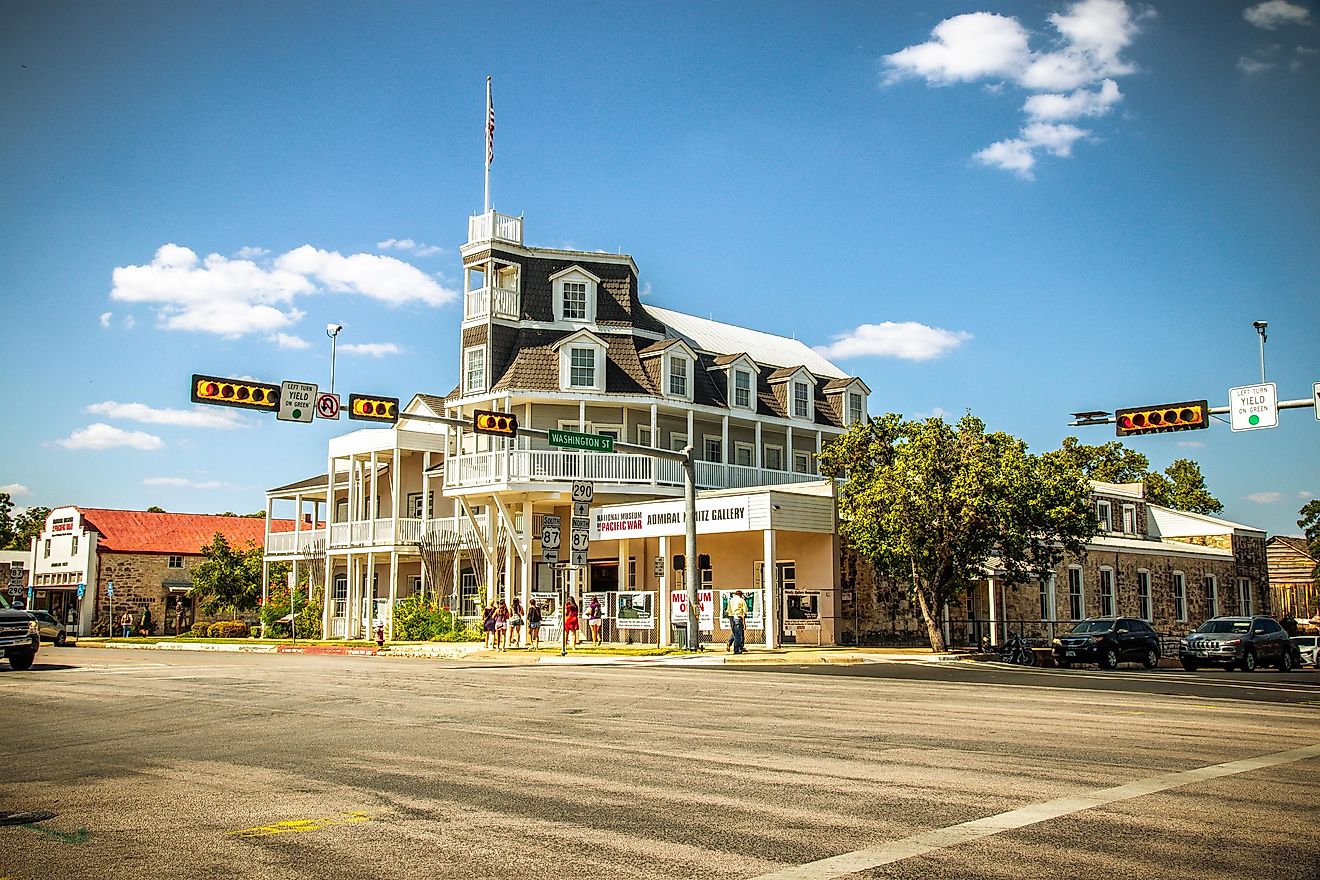
Texas's Best Small Towns for a Weekend Escape
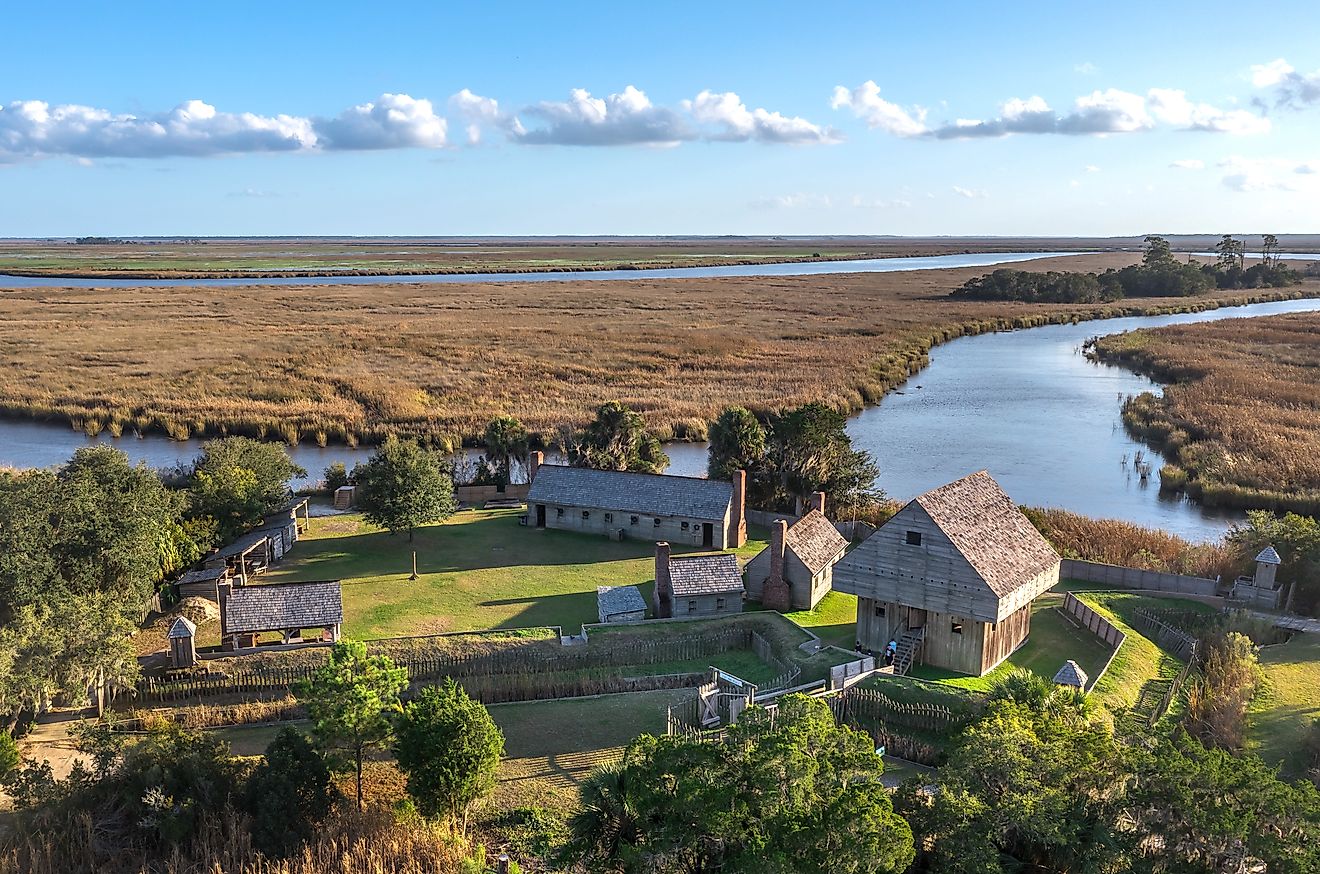
2024's 7 Most Beautiful Small Towns In Georgia
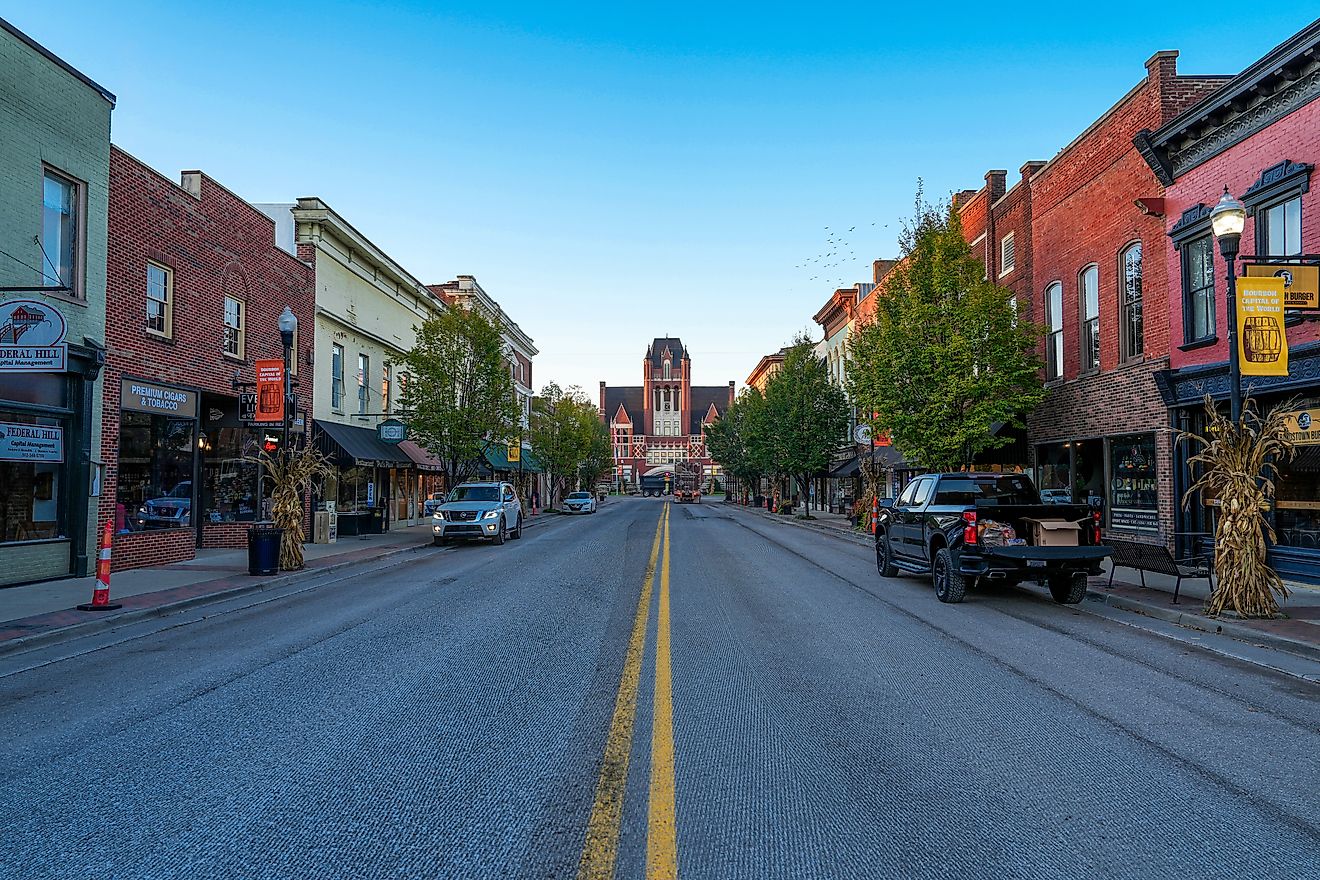
The Best Small Towns in Kentucky to Chill Out In 2024
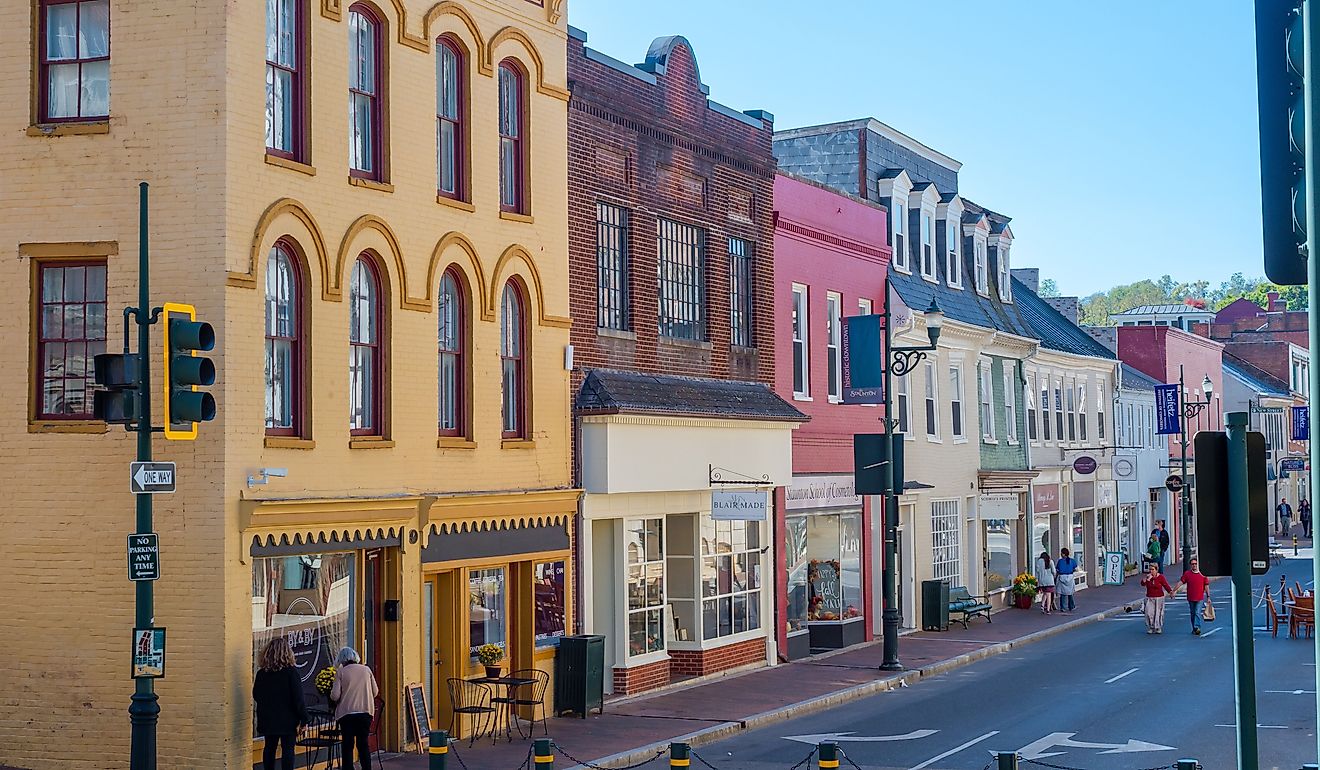
2024's 10 Most Beautiful Small Towns in Virginia
Musket balls found in Concord are believed to be linked to start of Revolutionary War

CONCORD — These shots may have been among those "heard round the world," but their remnants weren't found for nearly 250 years.
Five musket balls dating back to the start of the Revolutionary War were recently unearthed by archaeologists working at Minute Man National Historical Park .
“While the National Park Service and our partners work diligently to identify and protect natural resources and historical artifacts, the team of archeologists was not specifically looking for musket balls when they found them,” Mark Powell, a public affairs specialist with the Park Service, told Wicked Local.
He said the musket balls were discovered during what's known as "compliance activities," in preparation for the park’s Great American Outdoors Act project.
Noise pollution concerns: Minute Man Park is on '11 Most Endangered Historic Places List'
However, Minute Man has now embarked on additional archaeological investigations to determine whether more musket balls are within the 967-acre park, Powell said.
Musket balls believed to have been used by 1775 Colonial militia
Based on an early analysis of the musket balls, it's believed they were used by a Colonial militia who fired upon British soldiers during the April 19, 1775, battle at the North Bridge. This event, which started the Revolutionary War, is immortalized in the 1837 Concord Hymn by Ralph Waldo Emerson as “The Shot Heard Round the World.”
According to Powell, the musket balls were found on the eastern side of the Concord River within Minute Man National Historical Park, in an area where British soldiers formed up to resist the militia river crossing.
Each of the musket balls was fired from across the river, and not dropped during reloading, it was determined.
Recounting the 1775 battle at the North Bridge
The events of April 19, 1775, have come to be celebrated as the Battle of Lexington and Concord.
For generations, schoolchildren have been taught the story of Paul Revere and other midnight riders who traveled from Boston to Lexington warning that hundreds of British troops were marching toward Concord. Their warnings allowed the militia to meet the British soldiers on Lexington Green and engage in battle before the British, with reinforcements, proceeded to the North Bridge.
Just under 100 British soldiers remained at the bridge, while other companies marched to the farm of Col. James Barrett, who was believed to have a stockpile of munitions.
$27.4M in federal funds: Minute Man National Park prepares for 250th anniversary of Revolutionary War
Upon seeing smoke coming from the direction of the town, militia members, fearing the British were burning their homes, advanced toward the bridge, and when the British fired, the militia returned fire on the famous words of Concord’s Maj. John Buttrick, "Fire, fellow soldiers, for God’s sake fire!”
The British retreated to Concord.
The event at the North Bridge was a key turning point in the Battles of Lexington and Concord, and ultimately played a role in driving the British back to Boston. It's viewed as one of the most significant events in American history.
Visitors can view the musket balls today and learn more about “The Shot Heard Round the World” during the park’s Archeology Day events:
North Bridge Visitor Center (174 Liberty St., Concord)
- 10 a.m. to 4:30 p.m.: Members of the public can view the musket balls on display at the North Bridge Visitor Center. Visitors can talk to park curators about the musket balls and the science behind preserving them.
- 2:30 p.m.: “North Bridge Battle Walk.” Visitors can join park rangers for an interactive walking tour tracing the footsteps and the archaeology of those who fought at the North Bridge on April 19, 1775.
Minute Man Visitor Center (210 North Great Road, Lincoln)
- 11 a.m.: “Investigating Hallowed Ground: Battlefield Archeology at Minute Man National Historical Park,” with Joel Dukes, National Park Service Northeast Region Archeology Program.
- 1 p.m.: “Arms, Ammunition, and Archaeology: A Scientific Look at April 19, 1775,” with Joel Bohy, director of Historic Arms & Militaria at Blackstone Valley Auctions.
As a reminder, Powell stressed it's illegal for the public to use metal detectors in national parks. Furthermore, removing or tampering with archaeological resources within a national park is a federal crime.
“This is important to remember, because once a musket ball or other resource is moved, it is divorced from its context, and the object loses all meaning,” Powell said. "This is why trained archaeologists conduct surveys using precise scientific methods.”
Southbridge Boat House
Hours updated 1 month ago

Review Highlights

“ Now that Spring is here, I'd heartily suggest coming out here, and spending the day paddling up or down the River . ” in 21 reviews

“ We headed toward the Old North Bridge , which is part of the Minute Man historic park. ” in 5 reviews

“ Good prices, equipment is ok, but the best is the excursion to the minute man historic monument and house. ” in 3 reviews
Location & Hours
Suggest an edit
496 Main St
Concord, MA 01742
Upcoming Special Hours
You might also consider.

Walsh’s Deep Sea Fishing
21.2 miles away from Southbridge Boat House
Every Sunday we run an all day trip targeting haddock, red fish, cusk, and hake. We also run Overnight trips which is Captain Jims Specialty. Call us for availability at (781) 658-7958 Onboard transactions to be completed outside… read more
in Boat Charters, Fishing

Solitude Fishing Charters
Join us for a day on the water where every moment is an opportunity for a great catch. read more

Elevated Wake
Julianna M. said "Took a boating trip with them. The captain and staff were so friendly. The owners Pat and Jenna were so helpful in planning our adventure. They were very patient with new learners and had great tips. I had so much fun watching…" read more
in Boat Charters, Boating, Surfing
Amenities and More
4 More Attributes
About the Business
The South Bridge Boathouse offers canoe and kayak rentals to the general public with waterfront access to the historic waterways of the Assabet, Concord and Sudbury rivers. We are committed to making your experience safe and enjoyable. Please call us if you have any questions, we’re happy to assist you. Happy paddling! …
Ask the Community
Ask a question
Got a question about Southbridge Boat House ? Ask the Yelp community!
Recommended Reviews
- 1 star rating Not good
- 2 star rating Could’ve been better
- 3 star rating OK
- 4 star rating Good
- 5 star rating Great
Select your rating
Overall rating

Perfect spot for some weekend activity! Friendly staff and great location! Cameron did an excellent job in getting my party ready for some enjoyable kayaking experience.

Cash only!! (Only reason it's not a 5!) Plan ahead.... Solid service by Bri, and the young men who launch you and help you back in. Thanks for such an affordable, reliable kayaking opportunity. Part of my summer rituals now.... Know that the website is not current, either.... But what they do, they do well!

On the River

One of our sightings

Reasonable prices but cash only. Equipments are fine and easy renting. The old man and the young guy both were helpful. 1.5-2 hrs kayak/ canoe is totally worth it. Social distancing and masks are requiredat the dock at these convos times but later can be removed in the boats.

Had lot of geese accompany us!!

This goes back some time, but had the same experience as other reviewers here with the "older man" and felt compelled to write this review. Brought extended family (with young kids) to rent some canoes. Found the front desk empty during regular hours. Stepped onto the deck in front of the river to see if anyone was around. Eventually we noticed the "older man" by himself with some canoes. He ignored us. We asked if he worked here and he went ballistic. Started yelling at us and punching canoes. Getting violent and unpredictable. We retreated quickly to our car. Absolutely confused by the incident. We reached out to the owner by phone to report the incident and she basically told us "what do you want me to do about it?" As I understand it, he is related to the owner and she is well aware of this ongoing problem. Read the other reviews, this is not an isolated incident.

I really enjoyed Canoeing here, the concord river is huge so we canoed for 3+ hours but only covered a fraction of the river. The boat house has double kayaks, canoes, and single kayaks. Be aware that this place is CASH ONLY. They had someone help us get in and out of the boat which was nice. The price I believe is changed by hour then after 3 hours, the price no longer goes up. The facilities are on the older side but did not impact our experience. I would make five stars if they accepted credit card and/or could book from their website.

Good prices, equipment is ok, but the best is the excursion to the minute man historic monument and house. Make sure you pick a good, clear, and warm day for your excursion. The rental was quick and efficient. Not much training or "friendliness", just to business and off you go on the water.

Fun expeditions to minute man historical monument

David was great. He provided us with maps of the river, advised us on some hidden gems and shallow areas to watch out for, and was generally speaking just a really kind person. I was glad we ended up here - David's warm welcome was a great way to begin a lovely afternoon paddling trip. Will definitely be back.

How can you not be excited about getting on the water in this spot?
Love this beautiful spot! The new 3rd generation owner is amazing! She is so kind, professional, and hardworking. The customer service is top notch and the views on the river are stunning. Can't recommend this place enough!

What a great place this is. The prices could be a little less, but it's still worth it. The Sudbury River water isn't the cleanest but it's all good...the boathouse has nothing to do with that. They don't take debit or credit cards like the website says. They should update the site. I know that the boathouse may have survived some massive water damage throughout the years with floods...but it still upholds its charm. My experiences have been pretty fair when it comes to the staff. There's a lot of wild life which is a plus!

This is a lovely little spot to come to and have an 1 1/2 canoe or kayak down river through Concord. It's very pretty and we had the opportunity to take some wonderful pictures. The boat house has a working bathroom and lots of boats, the staff are young but helpful. There is an easiness to renting (cash only). They offer a lunch and dinner cruise that could be nice but the menu wasn't of interest. We would recommend this and do it again!

See all photos from Delilah A. for Southbridge Boat House
5 other reviews that are not currently recommended

Trinacria Fishing & Cruising Boston
Boston's Best Captain, Riccardo Buzzanga & Trinacria Fishing & Cruising will take you on an adventure of a lifetime or a breathtaking cruise. Boston Harbor and the waters just outside the harbor offer sights and excitement without… read more
in Boat Tours, Boat Charters, Fishing

River Angler
We bring a river raft; you bring a smile. Escape the hustle and bustle and join us on the river! We provide 2-3 hour walk and wade guided fly fishing outings on the Swift River in Massachusetts. We have an inflatable raft to get you… read more
in Fishing, Hunting & Fishing Supplies, Rafting/kayaking
Collections Including Southbridge Boat House

Fall Foliage Frolicking
By Kerri O.
People Also Viewed

Nashoba Paddler

Boating in Boston

Walden Pond State Reservation

Hopkinton State Park

Assabet River National Wildlife Refuge

Acton Arboretum

Great Brook Farm State Park
Riverfront Park
Best of Concord
Things to do in Concord
People found Southbridge Boat House by searching for…
Picnic Areas Concord
Best Boat Rental in Concord
Best Kayak Rental in Concord
Canoe Rental in Concord, Massachusetts
Top 10 Pontoon Boat Rentals in Concord
Browse Nearby
Things to Do
Restaurants
Campgrounds
Limo Service
Other Boating Nearby
Find more Boating near Southbridge Boat House

- SUBSCRIBE TO EMAIL
- Weather
Search location by ZIP code
Historic musket balls fired at british in 1770s found in concord, massachusetts, park.
- Copy Link Copy {copyShortcut} to copy Link copied!

GET LOCAL BREAKING NEWS ALERTS
The latest breaking updates, delivered straight to your email inbox.
Five musket balls that were fired during the event known as "The Shot Heard Round the World" on April 19, 1775, were recently discovered at Minute Man National Historical Park in Concord, Massachusetts.
National Park Service archeologists discovered the musket balls while conducting compliance activities in preparation for the park’s Great American Outdoors Act project.
According to the National Park Service, early analysis of the 18th-century musket balls indicates they were fired by colonial militia members at British forces during the North Bridge fight.
The North Bridge battle site is a key location within the National Historical Park and marks the moment when provincial militia leaders ordered members to fire upon their own government’s soldiers for the first time.
The event, which escalated an already boiling conflict between colonial rebels and British forces, was later called "The Shot Heard Round the World" by Ralph Waldo Emerson in his 1837 Concord Hymn.
According to the National Park Service, the musket balls were found in an area where British soldiers reportedly formed up to resist the river crossing.
Video: Patriots' Day reenactment held in Lexington
Park officials say further analysis of the musket balls indicates that each one was fired from the opposite side of the river and not dropped during the process of reloading.
"These musket balls can be considered collectively as ‘The Shot Heard Round the World,’ and it is incredible that they have survived this long," Minute Man Park Ranger and historic weapons specialist Jarrad Fuoss said in a news release. "It’s incredible that we can stand here and hold what amounts to just a few seconds of history that changed the world almost 250 years ago."
Visitors can view the musket balls and learn more about "The Shot Heard Round the World" on Saturday, July 13, during the park’s Archeology Day events.
The musket balls will be on display this Saturday at the North Bridge Visitor Center. Visitors can talk to park curators about the musket balls and the science behind preserving them.
Each year on Patriots Day, the events of that day, known collectively as the Battle of Lexington and Concord, are commemorated.
On that day, roughly 800 British soldiers marched from Boston to Concord to destroy military supplies that colonial rebels had gathered. Thousands of militia members intercepted the British advance thanks to a system of midnight riders who gave warning the night before.
Learn about the 250th Anniversary of the American Revolution at Minute Man National Historical Park visit.

COMMENTS
Minute Man is located 22 miles outside of Boston within the towns of Lexington, Lincoln and Concord, Massachusetts. The park commemorates the opening battles of the American Revolution on April 19, 1775 by protecting, preserving and interpreting the significant historic sites, structures, landscapes, events and ideas embodied by these events.
Begin your visit at the NPS Visitor Center on Marrett Road in Lexington and view the multimedia theater program about the battles there. A 6-mile walking trail or driving tour includes the area of Parker's Revenge, the site where Paul Revere was captured, the Minute Man Statue and the famous North Bridge in Concord.
Lexington Visitors Center. 1875 Massachusetts Ave, Lexington, MA 02420. 781-862-1450. The newly built Visitors Center was opened in June 2020, and is located right across the historic site, the Battle Green, where the first battle of the American Revolutionary War took place. The center offers several different costume guided tour options ...
A Revolution begins - A Nation is born. At Minute Man National Historical Park the opening battle of the Revolution is brought to life as visitors explore the battlefields and structures associated with April 19, 1775, and witness the American revolutionary spirit through the writings of the Concord authors.
Minute Man Visitor Center. Minute Man Visitor Center opens May 22, 2024. This visitor center is open Wednesdays, Thursdays and Fridays from 9:00 am -12:00 pm from July 1 - August 31, 2024. Restrooms are open 7 days a week from 9:00 am - 5:00 pm. "The Road to Revolution" multimedia presentation every 30 minutes starting at 9:00 am.
The British marched into Lexington and Concord intending to suppress the possibility of rebellion by seizing weapons from the colonists. Instead, their actions sparked the first battle of the Revolutionary War. The colonists' intricate alarm system summoned local militia companies, enabling them to successfully counter the British threat.
The Battles of Lexington and Concord, fought on April 19, 1775, kicked off the American Revolutionary War (1775-83). Tensions had been building for many years between residents of the 13 American ...
When 8 men were shot by British soldiers on Lexington Green just three years after the Boston Massacre, the countryside of Massachusetts fired back the blast we now call "the shot heard 'round the world." Hear the tale of the Midnight Ride of Paul Revere while traveling on the path he rode. Be stunned to stand on the site of the morning's first shootings in Lexington. Walk over the Old ...
The 250th anniversary of the historic battles of Concord and Lexington is approaching on April 19, 2025. Concord250 commemorates the semiquincentennial, or 250th anniversary of the American Revolution, which began here in New England. Two hundred fifty years ago, the men and women of what is now Massachusetts secured their independence from ...
Located 10 miles (16 km) from Downtown Boston and adjacent to Concord. Top attractions: Battle Green, the Minuteman Statue, Old Belfry, Buckman Tavern, Hancock Clarke House, Monroe Tavern, the Old Burying Group, Lexington Visitor Center. For more information, visit TourLexington. If you are human, leave this field blank.
Visit: Gettysburg Battlefield, PA. Over the course of three long days in the summer of 1863, 165,000 men met at Gettysburg and fought one of the most dramatic battles in Americans history, engaging in a fierce struggle over what kind of country the United States should be. Today, visitors can walk in the footsteps of the brave soldiers who ...
From Boston: Full-Day Historical Lexington & Concord Tour. 4.7 / 5 44 reviews. Activity provider: Great Boston Tours. Add to wishlist. Experience a deep dive into the start of the American Revolution. Enjoy stops in Lexington, Concord, and Charlestown, and jump into the key moments of the events of April 19, 1775, and independence.
The Battles of Lexington and Concord was the first major military campaign of the American Revolutionary War, resulting in an American victory and outpouring of militia support for the anti-British cause. The battles were fought on April 19, 1775, in Middlesex County, Province of Massachusetts Bay, within the towns of Lexington, Concord, Lincoln, Menotomy (present-day Arlington), and Cambridge.
Battles of Lexington and Concord. The Battles of Lexington and Concord on 19 April 1775, the famous 'shot heard 'round the world', marked the start of the American War of Independence (1775-83). Politically disastrous for the British, it persuaded many Americans to take up arms and support the cause of independence.
Megan - United States November 8, 2023 - Verified booking. Corinne - Switzerland October 13, 2023 - Verified booking. Relive the Battle of Lexington & Concord, where the "shot heard 'round the world" was fired! This self-guided driving/walking tour takes you through the dramatic battle that kicked off the Revolution!
Unlike Concord, the City of Lexington and its associated battle took place in what is now the heart of the town. The Lexington Common, where the battle took place, is open and accessible.
Explore the Battle Road Trail. This five mile trail connects historic sites from Meriam's Corner in Concord to the eastern boundary of the park in Lexington. The main theme of the trail is the Battle of April 19, 1775, that launched the American Revolution.
The Battle of Lexington and Concord marked the first battle of the American Revolutionary War. Let's talk more about the battle and the historic sites where key events took place. When was the Battle of Lexington and Concord? On the night of April 18, 1775, British troops marched from Boston to Concord to ruin the colonist's plan of rebellion.
The Battles of Lexington and Concord, the first shot of which would later be described by Ralph Waldo Emerson as 'the shot heard round the world', led to the Revolutionary War and the independence of the United States of America, becoming one of the key moments of the broader American Revolution (c. 1765-1789).
History: At dawn on April 19, 1775, 700 British troops arrived in Lexington and came upon 77 militiamen gathered on the town green, kicking off the American Revolution. The British Redcoats fired on the Colonials, killing 8 Colonial men and then continued on to Concord. Location : Battle Green, Lexington Center.
Thanks so much for your kind words, Katie! I'm happy you enjoyed the Battle of Lexington and Concord Audio Tour. It's great that the location-synced storytelling enhanced your exploration of Concord's notable spots. If you're keen on discovering more places, don't forget to check out my Action+ Tour Bundle for over 100 more self-guided tours.
Upgrade and Save: Upgrade to one of the below bundles and get the best value for your money! Massachusetts Bundle: Enjoy 12+ self-guided driving and walking tours in Massachusetts for $39.99 per person and save 73%. East Coast Fall Foliage: Immerse yourself in 20+ self-guided driving and walking tours for $74.99 and save 67%.
Fact #1: Minutemen vs. Militia. The most prevalent stories around Lexington and Concord is that of the "Minutemen.". If one visits Lexington and Concord today they will not only come across monuments to the Minutemen but also the National Park that commemorates the actions of April 19, 1775, is called Minute Man National Historical Park.
The movements of troops for both sides in the battle of Lexington and Concord focus on capturing rebel leaders in Lexington as well as to destroy the Americans store of weapons and ammunition in Concord.. What was the Battles of Lexington and Concord about? The Battles of Lexington and Concord (April 19, 1775) were the first skirmishes between British regulars and American provincials, kicking ...
Often referred to as the "Battles of Lexington, and Concord," the fighting on April 19, 1775 raged over 16 miles along the Bay Road from Boston to Concord, and included some 1,700 British regulars and over 4,000 Colonial militia. British Casualties totaled 273; 73 Killed, 174 wounded, 26 missing. Colonial casualties totaled 96; 49 killed, 41 ...
Like most of the towns here, the cuisine, culture, and shopping options are easily praised, but the layout and aesthetic of Concord deserve kudos of their own. Lexington Historic commercial building at 1740 Massachusetts Avenue at Waltham Street in historic town center of Lexington, Massachusetts, via Wangkun Jia / Shutterstock.com
Recounting the 1775 battle at the North Bridge. The events of April 19, 1775, have come to be celebrated as the Battle of Lexington and Concord.
50 reviews and 29 photos of SOUTHBRIDGE BOAT HOUSE "These folks rent, sell and repair kayaks and canoes. A great escape near the city, you can rent a canoe and kayak with paddles, cushions, maps, and life preservers and head out on the Concord or Sudbury River. It's a great idea for a quiet date, you can take a picnic lunch and pull over to the shore along the way.
Learn about the 250th Anniversary of the American Revolution at Minute Man National Historical Park visit. ... known collectively as the Battle of Lexington and Concord, are commemorated. ...
A Single Blow: The Battles of Lexington and Concord and the Beginning of the American Revolution, April 19, 1775. Emerging Revolutionary War Series. El Dorado Hills, CA: Savas Beatie, 2018. ISBN 978-1-61121-379-9. Frothingham, Richard Jr. (1903). History of the Siege of Boston and of the Battles of Lexington, Concord, and Bunker Hill. Little ...